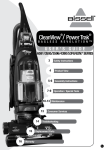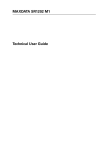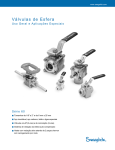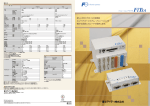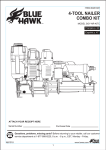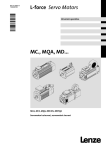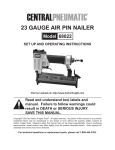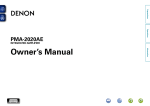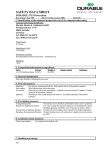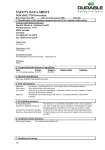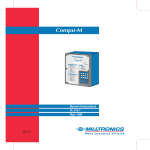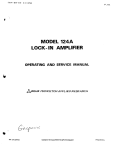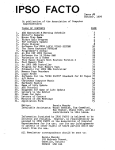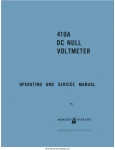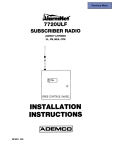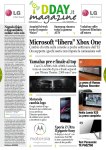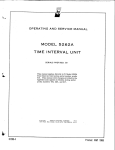Download Errata Title & Document Type: 211A Square Wave
Transcript
Errata
Title & Document Type: 211A Square Wave Generator Instruction and Operating
Manual
Manual Part Number: N/A
Revision Date: N/A
HP References in this Manual
This manual may contain references to HP or Hewlett-Packard. Please note that
Hewlett-Packard's former test and measurement, semiconductor products and chemical
analysis businesses are now part of Agilent Technologies. We have made no changes to
this manual copy. The HP XXXX referred to in this document is now the Agilent XXXX.
For example, model number HP8648A is now model number Agilent 8648A.
About this Manual
We’ve added this manual to the Agilent website in an effort to help you support your
product. This manual provides the best information we could find. It may be incomplete
or contain dated information, and the scan quality may not be ideal. If we find a better
copy in the future, we will add it to the Agilent website.
Support for Your Product
Agilent no longer sells or supports this product. You will find any other available product
information on the Agilent Test & Measurement website:
www.tm.agilent.com
Search for the model number of this product, and the resulting product page will guide
you to any available information. Our service centers may be able to perform calibration
if no repair parts are needed, but no other support from Agilent is available
Table of Contents
List of Illustrations and Tables
Model 211A
TABLE O F C O N T E N T S
Section
I
GENERAL INFORMATION
1
.
General Description
1
.
9
Damage in Transit
1.11
Power Transformer Conversion
..
.
. . . . . . . . . Page
1-1
.
.
.
.
.
.
.
.
.
. . . . . . . . .. .. 1-1
1-2
1-2
.. .. .. .. .. .. .. 2-1
2-1
2-1
.
.
.
.
.
.
.
.
.
................
2-1
.
.
.
.
.
.
.
. . . . . ............
. . . . . . . . . . 2-1
2-3
2-3
THEORY OF OPERATION . . . . . . . . . 3-1
31. . Introduction . . . . . . . . . . . . . 3-1
3
. . Sync Trigger . . . . . . . . . . . . . 3-1
3
.
7 . Multivibrator . . . . . . . . . . . . 3-1
3.12 . Clipper Amplifier . . . . . . . . . . 3-1
3-1 5. Power Amplifier . . . . . . . . . . 3-2
OPERATING INSTRUCTIONS
1
.
2
Controls and Terminals
2-11 Instrument Loading
2-17 Ringing
2.19
External Sync Operation
2.22
Pulses
2.24 Balanced Output
..
..
..
page
..............
. . . .. .. .. .. .. .. .. .. .. .. 4-1
4-1
4-1
........
. . . . . . . . 4-1
. . . . .. .. .. .. .. 4-1
.......
.........
..........
..............
Section
IV
MAINTENANCE
4
.
1
Introduction
4
.
3
Cabinet Removal
4
.
5
Equipment Required
4
.
7
Trouble Localization
4.12 Tube Replacement
4.15 Adjusting the Power Supply
4.20 Frequency Calibration
4.24 Adjusting External Sync Sensitivity
Sync Sensitivity
.
4.27 Waveform Observation and
Measurement
4.41
Servicing Etched Circuit
Boards
..
..
...
.
.
.
. . . . .. ..........
.. .. .. .. .. .. ..
REPLACEABLE PARTS
51
. Introduction
5
.
2
Ordering Information
..
LlST O F I L L U S T R A T I O N S
Page
Number
2-1
21
. Common Impedance Matching Networks
2
.
Front Panel Showing Operating Controls 2-2
3-1
3
.
2
Basic Output Circuit of 211A
4
.
2
Method of Obtaining a Balanced
3-3
Output from the 211A
..
......
.........
. Block
Diagram Showing Operating
Controls of 211A . . . . . . . . . . . .
. Model 211A Bottom View Showing
Amplifier and Power Supply. . . . . .
...
.
1
.
3
4
.
1
3-0
4-2
Number
4
.
2
Model 211A Top View
Test Setup for Frequency Calibration
4
.
3
4
.
Test Setup for Sync Sensitivity
75-Ohm Output Waveform which has
4
.
5
Defects on Positive Portion
4
.
6
Model 211A Waveforms
4
.
7
Voltage and Resistance Diagram
4.8
Multivibrator and Power Supply
4
.
9
Output Section
4.10
Range Switch Detail
4.11
Attenuator Switch Detail
..
..
.
.
..
..
.. .. .. .. ..
..............
...........
.........
LlST O F TABLES
Number
1
.
Specifications
4
.
1
Tube Replacement Chart
4
.
2
Test Equipment Required
4
.
3
Troubleshooting Chart
Page
. . . . . . . . . . 4-5
. . 4-6
. . . . . . 4-6
. . . .. .. .. .. .. ..
Page
1-1
4-0
4-1
4-3
.
................
.
..........
.
..........
...........
.
4
. . Calibration Chart . . . . . . . . . . . . . . 4-4
1
.
5 . Reference Designation Index . . . . . . . . 5-2
52
. . Replaceable Parts . . . . . . . . . . . . . 5 -7
Model 211A
Section I
Figure 1-1
Figure 1-1. Model 2 l l A Square Wave Generator
Section I
Paragraphs 1-1 to 1-5
Model 211A
SECTION I
GENERAL I N F O R M A T I O N
1-1. G E N E R A L D E S C R I P T I O N .
1-2. The @ Model 211A Square Wave Generator is a
precision wide range instrument particularly suited
for use with a fast oscilloscope for video amplifier
testing, permitting a rapid examination of amplifier
frequency characteristics up to many megacycles. In
computer, pulse code, telemetering, and similar applications it offers great convenience a s a variable trigger
source for switching purposes. In television work it
can serve as a bar generator. In highfrequency applications it is valuable a s a modulator source. It also
finds use in testinga variety of devices such as attenuators, filters, delay lines and audio systems.
1-3. The Model 2llAhas been designed with two outputs, one 75-ohm output and one 600-ohm output. The
rise time of the signal from the 75-ohm output is only
20 millimicroseconds, which is sufficiently fast to test
the response of video devices out to approximately 20
megacycles or toprovide a high speed triggeringvoltage of variable rate. The peak-to-peak amplitude of
the signal across the 75-ohm internal impedance is 7
volts, or 3.5 volts peak-to-peakinto a 75-ohm external
load. This output level may be adjusted with a 60-db
step attenuator in combination with an amplitude control, a particularly desirable arrangement when low
output levels a r e required.
1-4. The second output from the generator provides
55volts peak-to-peak from a source impedance of 600
ohms. The rise time of this signal is less than 0.1
microsecond with the output level controlled separately
from that of the 75 -ohm output. Both outputs a r e used
simultaneously.
1-5. The frequency range of the instrument, 1 cps to
1 mc, is covered in six 10/l bands. The frequency
Table 1-1. S~ecifications
Frequency Range :
1 cps to 1 mc, continuous coverage.
Low Impedance Output:
-3.5 volt peak across 75-ohm load -7 volt open
circuit, zero level clamped to chassis; rise time
less than 0.02 p e c .
Dimensions:
Cabinet Mount: 9-3/4 in. wide, 15-1/4 in. high,
14-5/8 in. deep.
Rack Mount:
t
m m nmm!BDL
1
1
High Impedance Output:
-27 volt peak across 600-ohm load -55 volt open
circuit, zero level clamped to chassis; rise time
less than 0.1 psec.
Relative Phase :
180° phase difference between high and lowimpedance output signals.
Amplitude Control :
Low Impedance Output - Potentiometer and 60
db attenuator, variable in 20 db steps.
High Impedance Output - Potentiometer.
Frequency Control:
Dial calibrated "1 to 10" and decade multiplier
switch. Six bands.
Symmetry Control:
Allows exact square-wave balance.
Sync Input :
Positive-going pulse or sine wave signal, min.
amplitude 5 volts peak.
Power:
ii5/230 volts +looh, 50-60 cps, 225 watts.
Cabinet Mount: Net 26 lbs, shipping 38 lbs.
Rack Mount: Net 25 lbs, shipping 34 lbs.
Accessories Available: (Cable Assemblies)
@ AC-16A. Four feet of RG-58C/U 50-ohm
coaxial cable terminatedwith dual banana plugs.
@ AC-16B. Four feet of RG-58C/U calbe terminated by a dual banana plug on one end and a
UG-88/U type BNC male connector on the other.
$9 AC-16D. Four feet of RG-58C/U cable terminated on one end by a BNC male connector.
@ AC-16K. Four feet of RG-58C/U cable terminated by BNC male connectors on each end.
Model 211A
Section I
Paragraphs 1-6 to 1-12
dial is linearly calibrated from 1 to 10. The six positions on the range switch multiply these calibrations in
decade steps.
1-6. For purposes of synchronization a Schmitt trigger circuit is located ahead of the multivibrator and is
set to trigger on a minimum input sync signal of 3 volts
peak, but a 5-volt peak sine wave or a positive pulse
signal is recommended for practical use. The sync
trigger provides a fast trigger of uniform rise and
amplitude which aids in obtainingaccurate time switching of the frequency multivibrator, and at the same
time isolates the. multivibrator from the input waveform. If no sync signal i s used the multivibrator
free-runs at a frequency controlled by the range switch
and the frequency control.
1-7. The multivibrator employs two type 6CL6 power
pentodes with precision components in the r c timing
networks. Residual variation in tubes or time constants may be compensated by a symmetry control
which balances the relative plate voltage swing on the
multivibrator tubes.
1-8. Two outputs are taken from the frequency multivibrator to drive a push-pull clipper amplifier consisting of two 6CL6's. The clipper serves a s the driver
for four 6CL6 power tubes arranged in push-pull
parallel a s the output power stage. Local feedback
is used in the power stage to stabilize the system
against variations in output level with a change in
frequency or range. This local feedback together with
a regulated power supply assures an output essentially
free from amplitude variations over the entire frequency range from 1 cps to 1 mc once the output
controls have been set.
1-9. D A M A G E IN TRANSIT.
1-10. After unpacking the instrument, should any
shipping damage be discovered, follow the procedure
described in the "Claim for Damage" sheet in this
manual.
1-11. P O W E R TRANSFORMER C O N V E R S I O N .
1-12. Should it be desired to operate the Model 211A
from a 210-250 volt source proceed a s follows:
a. Remove the two bare wire jumpers from the
terminal strip located beneath the power transformer.
These jumpers connect the Black to the Black-Green
lead and the Black-Red to the Black-Yellow lead of
the power transformer primary.
b. Insert a new jumper on the terminal strip which
will connect the Black-Yellow to the Black-Green lead.
c. Change line fuse F1 to one with a 1.25 ampere
slow-blow rating. As shown in the schematic diagram, this alteration changes the primary windings
of the power transformer from a parallel to a series
arrangement.
Section I1
Paragraphs 2-1 to 2-21
Model 211A
S E C T I O N II
OPERATING INSTRUCTIONS
2-3. RANGE. Switches time constants in the multivibrator circuit to establish various frequency ranges.
2-15. When it is desired to realize the 20 millimicrosecond rise time, 75-ohm output cable should be used
(RG-59/U). When it is desired to drive low impedance
systems other than 75 ohms, it is necessary to match
both ends of the output cable to its characteristic
impedance.
FREQUENCY. Varies the
to produce ':lo frequency change
RANGE switch position.
2-16. Physical arrangements for use in matchingthe
instrument output to common impedances a r e shown
in figure 2-1.
2-1.
2-2.
C O N T R O L S A N D TERMINALS.
ON. Applies line voltage to the instrument.
grid
On
each
2-5. OUTPUT AMPLITUDE. The 600 51 control
varies the amplitude of the signal at the 600 51 output
terminals. The 75 51 controlvaries the signal voltage
applied to the 75 51 output attenuator.
2-6. 75 51 ATTEN. This control reduces the output
jack in 20 db steps below the level set with the 75 51
OUTPUT AMPLITUDE control.
2-7. SYMMETRY. A balance potentiometer in the
multivibrator plate circuit which effectively balances
the amplitudes of the signals tothe multivibrator grids
and equalizes each square wave half cycle.
OUTPUT
75n
7 5 f i (RG-59lU)
75 n
OUTPUT
t
93 A (RG-62lU)
2-8. 600 51 OUTPUT. Two three-fourth inch spaced
binding posts which serve as the 600 51output, or as
a sync out connection when 7551 output is in use.
-
2-9. 75 51 OUTPUT. A female type BNC connector
serves as the 75 51output connector, o r a s a sync out
connector when the 60051 output is in use.
75
OUTPUT
2-10. SYNC IN. A female typeBNC connector to the
SYNC trigger which accepts sine waves or positive
pulse synchronizing signals with a minimum amplitude
of 5 volts peak. FREQUENCY control must be set at
a slightly lower frequency than the desired synchronized frequency.
2-11.
*
b
77:.
n
(RG-581.
-
SD-M-8
Figure 2-1. Common Impedance
Matching ~ e t w o r k s
INSTRUMENT L O A D I N G .
2-12. For low frequency applications involving high
impedance devices under test the output from t h e - 2 1 1 ~
may be taken from either the 75-ohm terminal or the
600-ohm terminal with little effect on the square wave
characteristic and the calibration of the 75-ohm
attenuator.
2-13. Low impedance devices, however, require
greater attention to impedance matching and line losses
in order to preserve attenuator calibration and to prevent deterioration of square wave shape.
2-14. The Model 211A produces a square-wave current pulse with a peak value of 100 ma across its
internal impedances. The use of the 75-ohm terminal
permits a fast rise square wave to be developed across
the 75-ohm internal impedance, and the 75-ohm attenuator allows these square waves to be reduced in amplitude without destroying their characteristics.
2-17. R I N G I N G .
2-18. Most video amplifiers o r r l c circuits resonant
below 30 mc a r e subject to ringingwhen hitwith a fast
rise pulse o r square wave. Care should be taken in
these cases to reduce this effect by proper matching
before assuming faulty operation of the Model 211A.
2-19.
EXTERNAL S Y N C OPERATION.
2-20. With the instrument externally synchronized,
the Schmitt trigger will control the switching of the
multivibrator only when the period of the multivibrator
is slightly greater than that of the external sync signal.
2-21. To permit the Schmitt-trigger output to fire
the multivibrator, set the FREQUENCY control to a
value slightly less than the frequency desired for sync
use. This setting permits the trigger pulse to fire
in a free-running recovery.
2-1
Model 211A
Section II
Figure 2-2
OUTPUT AMPLIT
LD- L- I9
1. RANGE. Select range of output frequency
desired.
2.
FREQUENCY. Select output frequency.
3.
OUTPUT AMPLITUDE 60052. Adjust output
signal voltage at 60052 output terminals.
6.
7552ATTEN. Attenuate voltage a t 7552output jack i n 20 db steps.
7.
OUTPUT SIGNAL. Source impedance 7552.
4.
OUTPUT SIGNAL. Source impedance 600%
8. SYMMETRY. Adjust square-wave output
voltage symmetry by viewing on cathode ray
tube.
5.
OUTPUT AMPLITUDE. Adjust output voltage a t 7552 output jack.
9. SYNC IN. Apply external signal t o synchronize square-wave output signal.
Figure 2-2.
Front Panel Showing Operating Controls
-
00093 3
Model 211A
Section I1
Paragraphs 2-22 to 2-29
2-22. PULSES.
2-23. The clipper amplifier and output tubes in the
Model 211A operate in a circuit designed for a 50%
duty cycle. The balance of this circuit is maintained
by the SYMMETRY control which balances the two
outputs from the multivibrator. Any alteration of this
circuit attempting to generate pulses, such as padding
the SYMMETRY potentiometer to extend its range of
control, would overdrive one side of the clipper amplifier and output tubes beyond the 50% duty cycle factor
to the eventual damage of the instrument.
2-24. B A L A N C E D O U T P U T .
2 -25. The 211A can be converted t o a balanced source
without modifying the instrument in any way. Figure
2-3 shows the basic arrangement of the output circuit.
The output tubesthemselves a r e in push-pull but have
unequal loads a s shown A balanced voltage can thus
be obtained by equalizing the tube loads. This can be
done directly at the terminals on the panel.
nn
7 5 n OUTPUT
LEVEL CONTROL
OUTPUT
T
figure 2-4. This additional resistance will reduce the
source impedance at the lower terminals to about 75
ohms and will also reduce the voltage available from
the lower terminals to approximately the same amount
available a t the upperterminal. At the same time the
additional resistance will form a more favorable time
constant with the stray capacity Co at the lower terminals and thus speed up the normally slower rise time
a t those terminals until it is comparable to that of the
75-ohm output.
2-27. Figure 2-4 suggests the use either of two 75ohm cables o r abalanced 150-ohm cable for connecting
to the load. In.either of these cases it is normally
unnecessary to terminate the cables, s o that they can
be connected directly to the load. The arrangement
has the advantage that it can be used with any load
impedance. If cables of other impedances a r e used,
they should be terminated inthe characteristic impedance of the cable. This will involve a consideration
of the load impedance in some cases.
75n
OUTPUT
BALANCED 1 5 0 n CABLE
0R
TWO 7 5 n COAXIAL cneLes
1
OUTPUT
-
-------
ATTENuATOR
OUTPUT
SEE TEXT-
Figure 2-4.
Figure 2-3.
Basic Output Circuit of 211A.
2-26. In figure 2-4 the upper terminal represents
the 75-ohm output and the lower terminals represent
the 600-ohm output. To equalize the source impedance
a t the two outputs, a resistance of 86 ohms can be
connected across the lower terminals as shown in
'
Method of Obtaining a Balanced
Output from the 2 11A
2-28. The output voltage can be selected most con2 ATTEN. output is first set to
veniently if the 75 S
zero. The two OUTPUT AMPLITUDE controls will
then have about the same voltage range and each should
be set as necessary to obtain one-half of the desired
output voltage. This will occur when both controls a r e
a t about the same angular position. If desired, both
line-to-ground voltages can be measured with a voltmeter o r an oscilloscope.
2 -29. Output voltage will be a s high a s 14 volts peakto-peak, open circuit, and 7 volts peak-to-peak terminated with 75 ohms.
Model 211A
Section III
Figure 3-1
OSYMMETRYAMPLITUDE 0
\
\
\
\
\
\
\
\
\
,
(SINE OR POS. PULSE)
ATTENUATOR
\
\
SYNC
IN
+75n
\
\
-
-
\
\
\
SCHMITT
TRIGGER
o.20.40,
I
-
PLATE
COUPLED
Iw -v
CLIPPER
AMPLIFIER
POWER
AMPLIFIER
I
+600fL
P
I
\
\
\
\
\
\
\
\
\
\
\
\
\
\
-
\
\
\
Figure 3-1. Block Diagram Showing Operating Controls of 211A
Section III
Paragraphs 3-1 to 3- 18
Model 211A
S E C T I O N Ill
CIRCUIT DESCRIPTION
3-1. INT~?ODUCTION.
3-2. Maior circuit elements a r e shown in the circuit
these
block diagram figure 3-1. Special aspects
circuit elements a r e discussed in subsequent paragraphs to supplement the general discussion in paragraph 1-1.
3-3. S Y N C TRIGGER.
3-4. The sync trigger is a Schmitt trigger which
switcheswith the application of a positive going signal
on the input grid. The circuit configuration is conventional f o r a Schmitt trigger except the L1 and L2 a r e
placed in the trigger-output circuit to produce spikes.
Since the Schmitt trigger changes state once on the
positive-going portion of an
signal and once on
the negative-going ~ " r t i o %two spikes a r e developed
across the L1, L2 differentiating circuit, one positive
and the other negative.
3-5. The
is
through CR1 to the
grid of one multivibrator tube (V3) cutting off conduction. Conduction then starts in V2. For the sync
trigger to effect a synchronized condition inthe multivibrator, the negative cut-off pulse from the trigger
must reach the grid of V3
the tube reaches
cut-off in a free-running condition. This is accomplished the operator
setting the free-running rate
(with the FREQUENCY dial) to a value slightlv less
than that of the incoming sync signals.
3-6. Output grid bias (effectively,sync sensitivity) in
the Schmitt-trigger circuit is adjusted with R10, thus
adjusting the cathode level. R10 is normally adjusted
s o that the triggering level is 3 volts above the level
of the trigger input grid.
3-7. M U L T I V I B R A T O R .
3-8. The multivibrator (V2 and V3) is a conventional,
free-running, plate-coupled multivibrator. The frequency of operation is varied by adjusting the grid
return voltage with R37 (FREQUENCY control) over
3-9. The RANGE switch S2 inserts various r c time
constants into the grid return circuit, and these time
constants establish the rate of decay for the cut-off
side of the multivibrator toward the voltage established
by the FREQUENCY control R37.
3-10. The diode clamp controls the current of the conducting side of the circuit and thus controls the voltage
drop across the plate load resistor of the conducting
half. This voltage is established by adjusting R31 on the
clamp control cathode follower V5. Since this adjustment determines the startingvoltage level for decay in
the section cutting off, it also exercises control over
the frequency of operation, and it is used t o calibrate
the instrument initially at 1000 cps on the XlOO range.
The function of the clamps is to stabilize the frequency
of operation against changes in the circuit such a s tube
aging, line voltage, and filiament fluctuations.
3-11. The output from the rnultivibrator furnishes a
push-pull drive for the clipper amplifier V6 and V7.
3-12. CLIPPER A M P L I F I E R .
3-13. Clipper amplifier tubes V6 and V7 alternately
conduct and cut-off in opposition, and serve a s the
drivers for the output tubes. The outputs from the
clipperamplifier are dc-coupled to the power amplifier stage through a broadband inter stage network consisting of C19, and R52, C20 and R53, togetherwith
the associated plate load resistors including ~ 5 5R56,
,
R57, R58, C21 and C22. This network is frequency
voltage on the grids
sensitiveto maintain a
of the output tubes. ~h~pipler.-,
amplifier output
voltages for low frequencies are developed across the
normal plate load resistors (R56, R50, R51, ~ 5 4 ) .
3-14. At high frequencies, the effective plate loads
a r e reduced to preserve fast r i s e time of the square
waves. The high frequency path is defined by C19,
C21 through C23 t o B+ at chassis ground, and by C20,
h
~ 2 through
2
C-3 to B+ at chassis ground. ~
this path the high frequency plate loads become R55
and R58, since these a r e small compared to the normalplate loads whichtheyparallel at highfrequencies.
3-15. P O W E R A M P L I F I E R .
3-16. The power amplifier consists of four type 6CL6
tubes arranged in push-pull parallel with a constant
resistance network in the cathode circuit, R65, R66,
R67, and L8. This network compensates for the effects of heater-cathode capacitance on the leading and
trailingedges of square wave output duringtube switching. The output tubes, like the clipper amplifier stage,
alternately conduct and cut-off. The compensating
network introduces a reactive transient into the circuit with a sign opposite to that produced by the tube
elements during switching.
3-17. Each side of the power amplifier furnishes a
separate output to the output stage of the instrument.
The low impedance output passes through a 75-ohm
potentiometer (OUTPUT AMPLITUDE control) to a
75-ohm three-section pi-filter. The 600-ohm output
passes through a 600-ohm potentiometer (OUTPUT
AMPLITUDE control) to the output terminals. The
600a OUTPUT AMPLITUDE control is a dual potentiometer and consists of two 1200-ohm sections inparallel to accommodate heat dissipation requirements.
3-18. Since the power supply is negativewith respect
to the chassis and the output is direct coupled, the
square wave is actually negative with respect tothe
ground terminal. Thus the negative portion of the
source wave is below ground potential and the positive
portion is at ground potential.
~
Model 211A
Section IV
Table 4-1
Table 4-1.
-
FUNCTION
TYPE
TUBE
Tube Replacement Chart
ADJUSTMENT REQUIRED
V1
6BQ7
Schmitt trigger
Adjust SYNC SENSITIVITY, paragraph 4-24
V2
V3
V4
V5
6CL6
6CL6
6AL5
6C4
1/2 Multivibrator
1/2 Multivibrator
Diode Clamp
Clamp Control Cathode Follower
Recalibrate
Recalibrate
Recalibrate
Recalibrate
V6
V7
V8
V9
V10
V11
6CL6*
6CL6*
6CL6*
6CL6*
6CL6*
6CL6*
7552 Output
60052 Output
7552 Output
7552 Output
60052 Output
60052 Output
No
No
No
No
No
No
V12
V13
V14
Vl5
5V3
6AS7GA
6BH6
5651
Full-Wave Rectifier
Series Regulator
Control Tube
Reference Tube
1
1
Clipper Amplifier
Clipper Amplifier
Tube
Tube
Tube
Tube
FREQUENCY dial,
FREQUENCY dial,
FREQUENCY dial,
FREQUENCY dial,
para.
para.
para.
para.
4-20
4-20
4-20
4-20
adjustment
adjustment
adjustment
adjustment
adjustment
adjustment
Check power
Check power
Check power
Check power
*Type 6197 tubes may be used i n place of type 6CL6 if desired
supply
supply
supply
supply
output
output
output
output
(paragraph
(paragraph
(paragraph
(paragraph
4-15)
4-15)
4-15)
4-15)
Model 211A
Section IV
Paragraphs 4-1 to 4-18
SECTION IV
MAINTENANCE
4-1.
INTRODUCTION.
4-2. This section contains instructions f or maintaining, troubleshooting, replacing tubes, and internal
adjustment of the Model 211A Square Wave Generator.
A systematic troubleshooting chart will assist in
localizing most troubles which may occur, and i t is
keyed to applicable paragraphs in the test tofacilitate
testing the instrument. Another chart includes instructions f or tube replacement and subsequent adjustments.
A table of important waveforms is given together with
a discussion of techniques and equipment necessary to
observe these fast rise waveforms.
4-3. C A B I N E T R E M O V A L .
4-4. To remove the instrument from the case, remove
the two machine screws onthe r e a r of the cabinet, and
slide the instrument forward.
4-5.
E Q U I P M E N T REQUIRED.
4-6. The test procedures in this section attempt to
isolate as many probable difficulties as possiblewith
a minimum of equipment. The nature and capabilities
of the instrument, however, require that the following
test equipment be available.
Table 4-2. Test Equipment Required
@Model 405 series o r 412A.
Electronic frequency counter
Frequency
(@ Model 523 or 524 series) or
Calibration
an oscillator and oscilloscope
for Lissajous patterns.
High frequency oscilloscope with
dc input feature and a vertical
Output Wave
Characteristics amplifier rise time of at least
0.012 psec, to check squarewave
leading edge output.
(@ Model 170A/162F)
Adjustment
4-7. TROUBLE L O C A L I Z A T I O N .
4-8. The Model 211A Square Wave Generator is a
precision instrument designed conservatively for long
component life. Tube replacement and adjustments
will repair a majority of difficulties which develop.
Isolation of a circuit failure is frequently possible by
considering the basic sections of the instrument a s
shown in the block diagram, figure 3-1.
4-9. The troubleshooting chart (see table 4-3) describes checks to be performed which locate specific
symptoms, together with possible causes and remedies. In the chart (table 4-3) only the tubes a r e
referenced, but it should be remembered that components associatedwith the referenced tubes a r e also
failure possibilities. The maintenance steps in the
chart should be performed inthe order given since the
chart assumes that the section aheadof the one under
investigation is operating correctly.
4-10. A voltage and resistance diagram has been included (figure 4-7) which gives values measured on a
normally operating instrument. In addition, a chart
of importantwaveforms observed on a typical instrument is given, together with a discussion of the equip ment and techniques needed to successfully observe
these fast rise waveforms (paragraph 4-27).
4-11. For all testing of the Model 211A the use of a
variable transformer toadjust the line voltage between
105 and 125 volts is recommended. An instrument in
satisfactory condition should operate over this range.
An instrument having marginal operation (from weak
tubes) can be quickly detected at low line voltages, and
weaknesses become easier to trace.
4-12.
TUBE REPLACEMENT.
4-13. Tubes used in the Model 211A Square Wave
Generator a r e listed in table 4-1. A tube may be replaced with any tube of its type having standard EIA
characteristics. Those tubes which require adjustment when replaced a r e accompanied by a reference to
the applicable paragraphinthis section of the manual.
4-14. The type 6CL6 tubes may be replacedwith their
ruggedized equivalents, type 6197, to take advantage of
the benefits of .this premium type. All references to
the 6CL6 apply equally to the 6197.
4-15. A D J U S T I N G THE P O W E R SUPPLY.
4-16. The power supply in the 211A must function
correctly before the instrument will operate properly.
Noise or variations in the regulated voltages may cause
the instrument to drift out of calibration and other
circuits to operate erratically.
4-17. To measure power supply voltage, connect a
dc voltmeter with i1%calibrated accuracy between the
end terminal of R10 (shown in figure 4-2) and the chassis. The voltage should be between -192 and -200 volts.
This voltage must be set to the point where regulation
is obtained under high (115 volts +lo%) and low (115
volts -10%) line conditions. A value of -195 volts is
average for most instruments.
4-18. If the voltage is set too low, regulation will be
lost under high-line conditions and excessive jitter
will occur in the leading edge of the output square
wave. If the voltage is set too high, loss of regulation
and leading edge jitter will be noted under low-line
conditions. Excessive jitter in the leading edge of the
output square wave will indicate loss of regulation
more quickly than a dc voltmeter connected directly
across the output of the power supply. This check
Model 211A
Section IV
Figure 4-1
Figure 4-1. Model 211A Bottom View Showing Amplifier and Power Supply
00093-8
Section IV
Table 4-3
Model 211A
Table 4-3.
Troubleshooting Chart
CHECKS AND SYMPTOMS
POSSIBLE CAUSE
1. POWER SUPPLY
With line voltage set at 115V, check that output
of regulated supply is at correct value (see
figure 4-2)
Slowly vary supply voltage from 105 to 125volts.
The negative output of the supply should not vary.
Replace V13, V14, V12 or
Excessive variation:
V15 in this order. V13,
V14 and V12 a r e most likely
to cause trouble.
Defective rectifier V12
Low voltage:
or regulator V13.
Defective controltube Vl4.
High voltage:
Erratic voltage:
Defective reference tube
V15.
REMEDY
Readjust R92, if necessary,
with 115V ac line. See
paragraph 4 -15.
Replace tubes; check supply;
see paragraph 4-15.
Replace; check supply; see
paragraph 4-15.
Replace; check supply; see
paragraph 4-15.
2. OUTPUT WAVEFORMS 75 52 OUTPUT
Observe and measure output waveform at 75
output terminals with a high-speed (30 mc
response) oscilloscope. See paragraph 4-27.
Adjust SYMMETRY control to mechanical
center.
Waveform grossly out of symmetry.
Cannot correct with control:
Leading edge rounding:
Defective V6, V8, or V9.
Replace; recalibrate XlOO
range. See DIAL CALIBRATION, this chart.
Replace. No adjustment.
Low peak voltage (75 52 out)
(600 52 output normal) :
Defective V6, V8, or V9.
Replace, No adjustment.
Power Supply.
Check paragraph 4-15 and
POWER SUPPLY, this chart.
Weak output (both 75S2 and 60052 outputs) :
Defective V6 and/or V7.
Replace. No adjustment.
Defective V2 or V3.
With dc input feature on scope, check 1 cps
output (be sure dc amplifier in scope is balanced)
Defective V2 or V3.
Sloping top on waveform:
Defective V6 thru V11.
Replace; recalibrate XlOO
range. See DIAL CALIBRATION, this chart.
Replace a s necessary.
No adjustment.
Replace a s necessary. No
adjustment.
Check leading edge of output at 1 mc
Rise time slow:
Defective V6 thru V11.
3. OUTPUT WAVEFORMS 60052 TERMINALS.
Observe and measure output waveforms at 600
terminals with a high frequency oscilloscope
with a rise time = O.Ol2psec or less (30 mc
response) if possible. See paragraph 4-27.
Leading edge rounding:
Defective V7, V10 or V11.
Replace a s necessary.
No adjustment.
Defective V10 or V11
Replace a s necessary.
No adjustment.
Low peak voltage (75 52 normal) :
Check 600 52 output at 1 cps and 1 mc a s described above (step 2).
Model 211A
Section IV
Paragraphs 4-19 to 4-23
Table 4-3. Troubleshooting Chart (cont'd)
CHECKS AND SYMPTOMS
POSSIBLE CAUSE
REMEDY
4. DIAL CALIBRATION
Check calibration at 1000 cps on XlOO rangewith
setup shown in figure 4-3.
Calibration tracking off more at one end
than at other:
Slight deviation:
Power supply not properly Check power supply.
set.
Adjust R31 for 1000s See
Out of adjustment.
paragraph 4-20.
Replace; recalibrate XlOO
Defective V2 and V3.
range. See paragraph 4-20.
Defective V4,
Replace; recalibrate XlOO
range. See paragraph 4-20.
.
Unable to adjust with R31:
Check
5. INPUT TFUGGER
Drive sync in with 5-volt peak 1000 % signal.
Set 211A dial to 980 cps. Test setup shown
in figure 4-4.
No sync:
Check range of sync to 950 cps.
Sync will not hold range:
Defective V1
Defective CR1 o r V1.
Sync normal at 1 kc lack of sync at 1mc:
L2 open
a. Set FREQUENCY dial on 211A to 10 and the
RANGE switch to X100.
is valid only when all other tubes in the instrument
a r e known to be good. Failure of the power supply
to regulate prcperly is generally an indication of weak
tubes. See table 4-3, Troubleshooting Chart.
b. Connect instrument output to either a counter
or to the horizontal sweep of an oscilloscope with a
stable oscillator drivingthe vertical sweep at 1000 cps.
4-19. If prevailing high or low line conditions occur
a t a location where a 211A is being used, the power
supply can be adjusted to partially compensate for any
adverse effects in instrument performance. The negative dc output of the power supply is referred to a s
-200 volts in the text and the schematic diagrams in
this manual. The actual voltage in an instrument will
vary from this figure as just described.
c. Adjust R31, shown in figure 4-2, to obtain 1000
cps from the Model 211A on the counter, or a zero
beat Lissajous pattern on the scope.
d. Repeat steps a and b above using 100 cps, with
FREQUENCY dial set to 1. Adjust R98 to obtain 100 cps
on the counter or a zero beat Lissajouspattern on scope.
4-23. Calibration of all ranges should be done in the
order shown in the Calibration Chart (table 4-41. If a
frequency counter is used for calibration, use period
measurement for steps 5 and 6, rather than frequency
measurement.
When using period measurement,
measure a total square wave period, rather than a
half-period, to eliminate SYMMETRY control effects.
4 - 2 0 . FREQUENCY C A L I B R A T I O N .
4-21. The output from the 211Ais adjusted tothe 1000
cps on the XlOO range with the FREQUENCY dial set
to 10. The operating frequency of the 211A on theXlOO
range is determined by the multivibrator operating
current (bias) which can be adjusted by potentiometer
R31 in the clamp circuit. All other ranges a r e calibrated by adjusting the r c time constants inthe timing
network after the XlOO range is correctly set.
Note
A 0.01 pf capacitor should be connected between the Model 211A output and the counter
input when making period measurement.
4-22. The test setup for frequency calibration is
shown in figure 4-3. The procedure is a s follows:
Table 4-4.
Perform Steps in Order
1.
2.
3.
4.
5.
6.
Set Range to:
XlOO
X1K
XlOK
XlOOK
XI0
X1
Replace; adjust sync sensitivity. See paragraph 4-24.
Replace; adjust sync sensitivity. See paragraph 4-24.
Replace; adjust sync sensitivity. See paragraph 4-24.
Calibration Chart
Set Dial to:
10
10
5
5
1
1
Adjust Pot.
Measure Frequency
Paragraphs 4-20, steps a through d
10,000 cps
R21
R20
50,000 cps
R19
500 kc
R23
10 cps (100 ms)
1 cps (1000 ms)
R24
Model 211A
Section IV
Figure 4-2
Figure 4-2.
Model 211A Top View
Model 211A
Section IV
Figures 4-3 and 4-4
\
f
/
\
-hp- MoDEL ellA
@
SQUARE WAVE
GENERATOR
@
MODEL
SERIES 523 OR 524
FREQUENCY COUNTER
0 0 0
00-
-hp-
\<
@
USE 0.01 UF CAPACITOR
WHEN MAKING PERIOD
MEASUREMENT
0 0
0 0
0
LD-L-24BC
i
\-~
Figure 4-3. Test Setup for Frequency Calibration
\
63
GND TO CHASSIS
OSCl LLOSCOPE
000
LOW CAPACITY
HIGH FREQUENCY
PROBE
f
HORIZ.
0
0
>
f
\
VERT.
\
1
LD-L-24BC
-hpMODEL200CD
WIDE RANGE
OSCILLATOR
-hp- MODEL 4 0 0 0 / H / L
VOLTMETER
0
@
I
Figure 4-4. Test Setup for Sync Sensitivity Adjustment
Model 211A
4-24. ADJUSTING EXTERNAL SYNC SENSITIVITY,
4-25, In the no-signal condition the input section of
the Schmitt-trigger tube V1 is biased approximately
3 volts below cut-off. Operation of the sync circuit
therefore requires an input signal of a t least 3 volts
peak amplitude.
4- 26. To adjust the sensitivity of the trigger:
a. Drive the SYNC IN connector with a 1000 cps
sine wave of 2.1 volts r m s (3.0 volts peak).
b. Connect oscilloscope through a law-capacity
probe t o pin 6 of V1. See figure 4-4.
Section IV
Paragraphs 4-24 to 4-39
megacycles. This corresponds to a rise time of approximately 0.012 microseconds. Approximate rise
time of an oscilloscope can be calculated by dividing
bandwidth into 0.35. For example, if bandwidth is 30
mc, the rise time is approximately 0.012 microsecond.
4-33, When using an oscilloscope with a 30 mc response (rise time = 0.012 microsecond), an e r r o r will
still be read in the rise time of the 75 52 output. The
true r i s e time of the 211A alone can be conveniently
computed, however. The formula is a s follows:
2 where to = actual rise time in
t0 = d t t
t2
microseconds
I
-
tl = observed rise time
c. Turn R10 to obtain a square-wave on oscilloscope.
t2
oscilloscope vertical amplifier
d. Turn R10 to maximum cw and waveform on
oscilloscope should disappear.
e. Adjust R10 counterclockwise until negative pulse
just appears on oscilloscope.
= known rise time of
4-34. As an example, the measured values takenfrom
a production unit which a r e shown in the waveform
charts figure 4-7A and 4-7B, indicate a rise time of
0.023 psec. The actual rise time is computed below:
f. This is correct adjustment of the SYNC sensitivity control for reliable external synchronization
with a positive-going pulse o r sine wave signal having
a minimum amplitude of 5 volts peak.
4-27.
WAVEFORM OBSERVATION A N D
MEASUREMENT*
4-28. The 211A is very reliable in that it is for the
most part a "go" o r "no go" type of circuit. If the
unit is operating normally, there is very little chance
that the rise time of the leading edge of the square
wave is slower than rated. Generally slow rise time
is due to weak tubes, however, it is possible that i f
a part has been damaged and has changed value, the
r i s e time may be less than rated.
4-29. The rise time of the 600-ohm output is less
than 0.1 microseconds with the OUTPUT AMPLITUDE
set at maximum. Reducing the setting of the 600 SZ
OUTPUT AMPLITUDE control to approximately a dial
setting of "2" will give a voltage level approximately
the same as that from the 75-ohm output jack. The
rise time will be improved due to reduced shunting
effect of circuit capacity. A r i s e time of essentially
the same a s that from the 75-ohm output jack is possible under these conditions.
4-30.
A low capacity probe specifically designed for
high frequencies should be used for observing wave-
forms. Certain probes may tend to ring at a high
frequency when hit with very fast pulses.
4-31. To measure the rise time of the 600 SZ output,
which is approximately 0.1 microsecond, an oscilloscope with a bandwidth of 10 megacycles is quite adequate. Excellent oscilloscopes for this purpose a r e
the @Model 160B o r 150A.
4-32. TOACCURATELY MEASURE THE RISE TIME
OF THE 75 52 OUTPUT REQUIRES AN EXTREMELY
HIGH SPEED OSCILLOSCOPE. The oscilloscope vertical amplifier should have a bandwidth of a t least 30
to = 0.0196 microseconds actual risetime of the 211A
Square Wave Generator.
4-35. The typical waveforms shown in figure 4-7A, B
can be observed with the following equipment:
a. Oscilloscope: ($9 Model 170A with 162F P r e amplifier, o r Tektronix Type 545A with type K Preamplifier (use either instrument).
b. Probe: ($9 Model AC-21A (10:l) o r AC-21C (50:l).
4-36. Use of an oscilloscope which is not in good
operating order a s far a s high frequency signals a r e
concerned, may cause the 1 mc square wave to look
slightly uneven across the top, even though it is perfectly square at low frequencies. A simple check to
determine i f the trouble is in the oscilloscope o r in
the 211A is to use d-c couplingwhen observing a 1 mc
square wave from the 75-ohm output.
4-37. Since the 211A square wave is negative going
with respect to ground, the highest part of the square
wave must be in fact at zerovolts. While ond-c coupling, ground the probe and note the position of the
trace on the graticule, then note i f the highest part
of the square wave exceeds the point of zero volts. If
it does, the oscilloscope is a t fault.
4-38. If the oscilloscope is proven not to be at fault,
one of the tubes in the 211Ais weak and should be replaced. The two situations a r e shown in figure 4-6.
4-39. When observing a 1mc square wave there may
be a very small amount of overshoot o r undershoot a t
the leading edge of the bottom of the negative portion
of the square wave. This is normal. A shorted C24
will cause approximately 5-10 volts drop in amplitude
of the 600 output and a slightly slower rise time.
Section IV
Paragraphs 4-40 to 4-42
Model 112A
4-40. If C19, C20, C21, or C22 have too much capacity or i f the associated resistors R52, R53, R56, and
R57 have low resistance, there will be overshoot on
the square wave. If the capacity of any of these capacitors is low or the associated resistors have for some
reason increased in resistance, there will be undershoot o r rounding of the corner of the leading edge of
the square wave. Before any changes in these parts
a r e made, however, every effort should be made to
correct the trouble with good tubes a s this is the nor ma1 reason for poor waveshape. Unless these parts
have changed value, these circuits should not need
adjustment. No adjustment should be attemptedunless
a 30 megacycle oscilloscope is available to determine
when the compensation is correct.
CAUTION
To avoid accidental damage, always turn off
power before removing or installing circuit
board assemblies.
SYNCHROSCOPE
AT FAULT
Figure 4-5.
4-41. S E R V I C I N G ETCHED C I R C U I T BOARDS.
4-42. The Model 211A is supplied with single-sided
etched circuit boards; i. e., conductive material is
located only on one side of the boards. Funneled eyelets insure good electrical contact between component
leads and conductor. When servicing these boards,
the following general rules should be followed:
a. DO NOT APPLY EXCESSIVE HEAT to components o r conductor.
b. To remove damaged components, clip leads near
component; then apply heat and remove leads with a
.
straight upward motion.
c. Use a toothpick or wooden splinter to clean component mounting holes before installingnew components.
d. APPLY SOLDER FROM CONDUCTOR SIDE of
board to insure good contact between eyelets, comp.0nent lead, and conductor.
AT
211 A
FAULT
75-ohm Output Waveform which has Defects on Positive Portion,
a s Observed with a DC Coupled Oscilloscope
RO
Section IV
Figure 4-6
Model 211A
IKC SQUARE WAVE
V6
600-ohm output
PIN 2
I KC
I MC
Amplitude control
set at "10"
0.1 p e c / c m
50 volts/cm
600 -ohm output
Amplitude control
set a t approx. "2"
5 volts/cm
2 0 0 kS/CM
SV/CM
082 pS/CM
SV/CM
V6
PIN6
75-ohm output
Controls set for
maximum output
5 volts/cm
200 pS/CM
20V/CM
Oa2 b S / C M
20V/CM
7 5-ohm output
0.02 psec/cm
X50 attenuation
10 megohm probe
used
V8
Gain adjusted to
give 10 divisions
vertical deflection
for ease in measuring rise time of
leading edge of
square wave
2 0 0 WS/CM
5 V/CM
PIN9
0.2 kS/CM
5 V/CM
I MC SQUARE WAVE 75-ohm output
Same test conditions a s for 1 kc
Note that rise time
is the same at 1 mc
a s a t 1 kc
NOTE: Since the circuit is balanced, the
waveforms on V7 and V10 a r e the
same a s those on V6 and V8.
Figure 4-6A
Figure 4-6B
Figure 4-6. Model 211A Waveforms
NOTES.
I. CONDITIONS OF MEASUREMENT
ALL VOLTAGES AND RESISTANCES MEASURED TO CHASSIS
WITH 20.000!llVOLT MULTIMETER UNLESS OTHERWISE
SPECIFIED BY ASTERISK(t1
:*N.C.
INPUT IMPEDANCE VTVW
2. CONTROL SETTINGS
RANGE XI00
FREQ DIAL :I 0
.
3 li.looon
M = YEGOHM
N.C = NO CONNECTION
--
lad 2
230VAC
lt DC VOLTAGES SO MARKED MEASURED WITH 122 MEGOHM
' 5 4'
23lvAC
19K
Figure 4-7.
Voltage and Resistance Diagram
SYNC TRIGGER
-
-
.c.
-
-
--CIS
".OW~
,
('R37
7:fLq
R12
422
R98
5K
L4
0
R3
3900
.22UF
41
-TO
IRI.6EI
FREO
SWITCH
.2PUF
Osl
V6
TO
RY)
2700
V7-1
-9.5
.OIlIF
1
I
-
[6S"q
BROWN
BRW*
-
-4
-5
-5
.
TO TERMINALS
"'
"6
-4
.OIpF
TO 6.3AG IGRNDI*
1 6 7 OF L 8
540
-
R87*
a m
-195v
6C4
RW
9a5K
CLAMP
CONTROL
@
,
ULIIU)ATE
IOOO'L X M O
R M E
R31
50K
R32
I.03IY
colnsm
IVSI
IV
dn-il
."d
"."Im.,*.ur.
.Id 8.
,*I.
..F.od.<.d
I.
1.1
..l*.U
*.~I.ll .~.,..d
111.-,-
-195v
Figure 4-8.
Multivibrator and Power Supply
,on.
MWL~.~ACKUD
*.
mur*wr
.*..w..
in,."d.d
lor 6
. opn,i.m
.)
I. b. .l*,...L~d
"..a
3u*
r. .
rn"." r
o".",
cmmgn,.
n,
h.
h)
*
w
w
S2
1-
CLIPPER AMPLIFIER
..
0------.,
leoosl
I.OWI
.*
OUTPUT AMPLIFIER
371.3
R7T
371.3
1180
RSI
2000
R
2 a4X6)
I
1
41
at
R45
47
V6
-Jo
6CL6'"
C 17
NOTES:
R69
22OK
I
I-,
R43
27K
I CONTROL SETTINGS:
-
7RANGE
5
ATTEN
-XI00 6 0 0 s
FREQ D I A L - I 0
2. A L L DC VOLTAGES MEASURED TO CHASSIS WITH
A VACUUM TUBE VOLTMETER HAVING 122 MEGOHM
INPUT IMPEDANCE
OPTIMUM VALUE SELECTED AT FACTORY. AVERAGE
VALUE SHOWN CAPACITY IN PF. RESISTANCE IN
OHMS UNLESS OTHERWISE NOTED.
PANEL c m m o ~
MARKING
-l60
+
,
0.
&.
R47
470
LPANEL
I
CHISSlS
-19sv-
f l OF
P R6CL6
E M l VIFYOFSIRED.
NBEMPEU97MAYBEUSmlNRYX
R 40
IM
Figure 4-9.
Output Section
PANELEND
OF SWITCH
-m(4) REAR mEOFWAFfRS SHOWN.
(8) FACING FRONTOF PANEL ,CW
ROTATION OF RANGE swrcn
KNOB EWIVALENT TO CCW ROTATION OF ROTORS SHOWN A M .
R21 @
L ---,
,& -------
I
I
-l
(C) CAPACITANCE IN U!JF UNLESS
OTHERWISE SHOWN.
(0) RESISTANCE IN Omrs UNLESS
OTHERWISE SHOWN.
Figure 4-10. Range Switch Detail
Model 211A
Section IV
Figure 4-11
-NOTES(A1 REAR FACE OF WAFERS SHOWN
(8) FACING FRONTOF PANEL,CW ROTATION OF
ATTENUPTOR s w l n n KNOB IS EQUIVALENT
TO CCW ROTATION OF ROTORS SHOWN BELOW.
R75
91.67
M6
IC1
CAPACITANCE IN U P F
(0)
RESISTANCEIN OHMS
91.67
RIB
91.67
R79
91.67
RBI
91.67
40DB
OUTPUT
R72,
,- 7 5
AMPLITUDE CONTROC
SWITCH SHOWN IN 6 0 0 6 POSITION
Figure 4-11. Attenuator Switch Detail
Model 211A
Section V
Paragraphs 5-1 to 5-7
SECTION V
REPLACEABLE P A R T S
5-1. I N T R O D U C T I O N .
5-4. O R D E R I N G I N F O R M A T I O N .
5-2. This section contains information for ordering
replacement parts. Table 5-1 lists parts in alphanumerical order of their reference designators and
indicates the description and $3 stock number of each
part, together with any applicable notes. Table 5-2
lists parts in alpha-numerical order of their $' 3 stock
numbers and provides the following information on
each part:
5-5. To order a replacement part, address order or
inquiry either to your authorized Hewlett-Packard
sales representative o r to
CUSTOMER SERVICE
Hewlett-Packard Company
395 Page Mill Road
Palo Alto, California,
a. Description of the part (see list of abbreviations
below).
or, in Western Europe, to
Hewlett-Packard S. A.
Rue du Vieux Billard No. 1
Geneva, Switzerland.
b. Manufacturer of the part in a five-digit code;
see list of manufacturers in appendix
c. Typical manufacturer's stock number.
d. Total quantity used in the instrument (TQ column).
e. Recommended spare part quantity for complete
maintenance during one year of isolated service (RS
column).
5-3. Miscellaneous parts not indexed in table 5-1 a r e
listed at the end of table 5-2.
5-6.
Specify the following information for each part:
a.
b.
c.
d.
Model and complete serial number of instrument.
Hewlett-Packard stock number.
Circuit reference designator.
Description.
5-7. To order a part not listed in table 5-1, give a
complete description of the part and include its function and location.
REFERENCE DESIGNATORS
A
B
C
CR
DL
DS
E
assembly
motor
capacitor
diode
delay line
= device signaling (lamp)
= misc electronic part
F
FL
J
K
L
M
MP
a
= amperes
bp
bwo
= bandpass
= backward wave
elect = electrolytic
encap= encapsulated
=
=
=
=
=
=fuse
= filter
= jack
= relay
= inductor
= meter
= mechanical part
plug
transistor
resistor
thermistor
switch
transformer
'
V
= vacuum tube, neon
W
X
XF
WS
= cable
= socket
= fuseholder
= lampholder
= network
h l b , photocell, etc.
Z
ABBREVIATIONS
oscillator
=
c
cer =
cmo =
coef =
com =
comp =
conn =
crt =
carbon
ceramic
cabinet mount only
coefficient
common
compsition
connection
cathode-ray tube
f
fxd
= farads
Ge
grd
= germanium
= ground (ed)
h
Hg
= henries
=fixed
d:p
= deposited
EIA
= Tubes o r transistors
K
= kilo = 1000
lin
log
= linear taper
= logarithmic taper
4
0)
A
A
o
m
M
ma
NC
Ne
NO
NPO
nsr
= mercury
impg = impregnated
incd = incandescent
ins = insulation (ed)
meeting Electronic
Industries' Association standards will
normally result in
instrument operating
within specifications;
tubes and transistors
selected for best
performance will be
supplied if ordered
by @stock numbers.
mtg = mounting
my = mylar
=milli=10-~
= megohms
= milliamperes
p
= micro =
minat = miniature
mfgl = metal film on glass
mfr = manufacturer
obd
normally closed
neon
normally open
negative positive zero
(zero temperature
coefficient)
= not separately
replaceable
=
=
=
=
S-b
= slow-blow
Se
= selenium
sect
Si
sil
sl
= peak
= printed circuit
board
picofarads =
10-12 farads
peak- to- peak
peak inverse
voltage
position(s)
polystyrene
potentiometer
rect = rectifier
= section(s)
= silicon
= silver
= slide
td
= time delay
T i 0 = titanium dioxide
2
= order by de-
scription
PP
piv
rot = rotary
r m s = root- mean- square
rmo = rack mount only
tog
to1
trim
twt
= toggle
= tolerance
var
w/
W
= variable
= watts
ww
= wirewound
w/o
= without
*
= optimum value
= trimmer
= travelingwavetube
= with
selected at factory,
average value
shown (part may
be omitted)
Section V
Table 5-1
Model 211A
Table 5-1.
Circuit
Reference
($3
Reference Designation Index
Description #
Stock No.
C1
C2
C3
C4
C5
0160-0051
0140-0033
0140-0035
0140-0090
0140-0018
C:
C:
C:
C:
C:
fxd,
fxd,
fxd,
fxd,
fxd,
my, 0.47 pf *lo%, 400 vdcw
mica, 5 pf rt20%, 500 vdcw
mica, 39 pf *5%, 500 vdcw
mica, 200 pf *5%, 500 vdcw
mica, 1000 pf *5%, 500 vdcw
C6
C7
C8
C9
C10
0 140-0'009
0160-0022
0160-0018
0140-0035
0140-0090
C:
C:
C:
C:
C:
fxd,
fxd,
fxd,
fxd,
fxd,
mica, 0.01 pf *5%, 500 vdcw
my, 0.1 pf *5%, 600 vdcw
my, 0.22 pf *lo%, 400 vdcw
mica, 39 pf *5% , 5OOvdcw
mica, 200 pf *5%, 500 vdcw
C11
C12
C13
C14
C15, C16
0140-0018
0140-0009
0160-0022
0160-0018
0150-0012
C:
C:
C:
C:
C:
fxd,
fxd,
fxd,
fxd,
fxd,
mica, 1000 pf *5%, 500 vdcw
mica, 0.01 pf *5%, 500 vdcw
my, 0.1 pf *5%, 600 vdcw
my, 0.22 pf *lo%, 400 vdcw
c e r , 0.01 pf *20%, 1000 vdcw
C17,
C19,
C21,
C23,
C25
0170-0002
0140-0098
0140-0099
0150-0012
0180-0025
C:
C:
C:
C:
C:
fxd,
fxd,
fxd,
fxd,
fxd,
my, 2 pf *20%, 400 vdcw
mica, 200 pf *I%,500 vdcw
mica, 1000 pf *I%,500 vdcw
c e r , 0.01 pf *20%, 1000 vdcw
elect, 4 sect, 20 pf/sect. , 450 vdcw
C26
C27
C28 thru C32
C33, C34
0160-0013
0180-0011
0140-0004
0150-0012
C:
C:
C:
C:
fxd,
fxd,
fxd,
fxd,
my, 0.1 pf *10%, 400 vdcw
elect, 20 pf, 450 vdcw
mica, 1 5 pf *lo%, 500 vdcw
c e r , 0.01 pf *20%, 1000 vdcw
CR1
1910-0009
Diode, Ge
F1
2110-0015
Fuse,
(for
Fuse,
(for
C18
C20
C22
C24
2110-0021
Note
cartridge: 2.5 amp, s-b
115 V operation)
cartridge: 1.25 amp, s-b
230 V operation)
I1
2140-0012
Lamp, minat : 2 pin base, 6.3 V, 0.15 amp, #12
J1, 52
1250-0118
Connector: BNC (rack model)
1250-0083
Connector: BNC (cabinet model)
# See introduction to this section
00093-3
Section V
Table 5-1
Model 211A
Table 5-1. Reference Designation Index (conttd)
1
Circuit
Reference
Description #
@ Stock No.
L1
L2
L3
L4, L5
L6, L7
9140-0026
9140-0022
9140-0025
9140-0024
Inductor: RF,
Inductor: RF,
Not assigned
Inductor: RF,
Inductor: RF,
L8
211A-60A
Inductor: RF, (special)
P1
8120-0050
Cord, power
Rl
R2
R3
R4
R5
0687-1051
0690-1041
0690-2731
0687-1021
0690-2221
R:
R:
R:
R:
R:
fxd,
fxd,
fxd,
fxd,
fxd,
6.8 ph
500 ph
R6
R7
R8
R9
RlO
0693-4721
0693-3921
0687-3341
0690-8231
2100-0084
R:
R:
R:
R:
R:
fxd, comp,
fxd, comp,
fxd, comp,
fxd, comp,
v a r y comp,
4.7K ohms *lo%, 2 W
3.9K ohms *lo%, 2 W
330K ohms *lo%, 1/2 W
82K ohms *lo%, 1 W
50K ohms *20%, 1/3 W
Rll
R12
R13
R14
R15
0687-4701
0727-0073
0687-4701
2100-0079
0730-0079
R:
R:
R:
R:
R:
fxd, comp,
fxd, dep c ,
fxd, comp,
v a r y comp,
fxd, dep c ,
47 ohms a 0 % , 1/2 W
422 ohms *I%,1/2 W
47 ohms *lo%, 1/2 W
250 ohms *lo%
216.3K ohms *l%,
1W
R16
R17
R18
Rl9, R20
R21
0730-0087
0730-0096
0730-0118
2100-0013
2100-0063
R:
R:
R:
R:
R:
fxd, dep c ,
fxd, dep c ,
fxd, dep c ,
v a r y comp,
v a r y comp,
370K ohms *l%,
1W
683.7K ohms *I%,1 W
3.05M *l%,
1W
lin, 50K ohms *20%
lin, lOOK ohms
R22
R23
R24
R25
R26
0730-0045
2100-0013
2100-0074
0730-0079
0730-0087
R:
R:
R:
R:
R:
fxd, dep c ,
v a r y comp,
v a r y comp,
fxd, dep c ,
fxd, dep c ,
30.5K ohms *I%,1 W
lin, 50K ohms *20%
lin, 1M E30%
216.3K ohms *I%,1 W
370K ohms *l%,
1W
R27
0730-0096
R: fxd, dep c, 683.7K ohms *I%,1 W
4.7 ph
0.68 ph
*lo%,
1/2 W
lOOK ohms *lo%, 1 W
27K ohms *lo%, 1 W
1K ohms *lo%, 1/2 W
2.2K ohms i10%, 1 W
C O ~ P , 1M
comp,
comp,
comp,
comp,
Note
# See introduction to this section
5-3
Section V
Table 5-1
Model 211A
Table 5-1. Reference Designation Index (contld)
Circuit
Reference
Description #
($3 Stock No.
R28
R29
R30
R31
R32
0730-0118
0730-0017
0730-0065
2100-0084
0730-0106
R:
R:
R:
R:
R:
fxd,
fxd,
fxd,
var,
fxd,
dep c ,
dep c ,
dep c ,
comp,
dep c,
R33
R34
R35
R36
R37
0687-4701
0727-0073
0811-0004
0687-4701
2100-0130
R:
R:
R:
R:
R:
fxd,
fxd,
fxd,
fxd,
var,
comp, 47 ohms *lo%, 1/2 W
dep c, 422 ohms *I%,1/2 W
ww, 540 ohms *l%,
5W
comp, 47 ohms *lo%, 1/2 W
ww, 50K ohms *l%,
8W
R38
R39, R40
R41
R42
R43
0690 -2721
0687-1051
0687-6831
0687-8231
0687-2731
R: fxd, comp,
R: fxd, comp,
R: fxd, comp,
R: fxd, comp,
R: fxd, comp,
R44, R45
R46
R47
R48, R49
R50, R51
0687-4701
0763-0001
0771-0002
0687-4701
0763-0001
R: fxd,
R: fxd,
R: fxd,
R: fxd,
R: fxd,
comp, 47 ohms *lo%, 1/2 W
mfgl, 2K ohms *I%,2 W
mfgl, 470 o h m s *lo%, 4 W
comp, 47 ohms *lo%, 1/2 W
mfgl, 2K ohms *I%,2 W
R52, R53
R54
R55
R56, R57
R5 8
0730-0091
0763-0001
0730-0007
0730-0066
0730-0007
R:
R:
R:
R:
R:
dep c, 479K ohms *l%,
1W
rnfgl, 2K ohms *I%,2 W
dep c , 230 ohms *l%,
1W
dep c , 95.5K ohms *I%,1 W
dep c , 230 ohms *l%,
1W
R59 thru' R64
R65
R66
R67
R68
0687-4701
0771-0002
0690-2711
0771-0002
0687-4701
R: fxd, comp, 47 ohms *lo%, 1/2 W
R69
R70
R71
R72
R73
0687-2241
0687-4701
2100-0075
2100-0076
0727-0324
R: fxd,
R: fxd,
R: v a r ,
R: v a r ,
R: fxd,
fxd,
fxd,
fxd,
fxd,
fxd,
Note
3.05 M *I%,1 W
1.5K ohms *I%,1 W
90.5K ohms *l%,
1W
50K ohms *20%, 1/3 W
1.031M *I%,1 W
2.7K ohms *lo%, 1 W
1M *lo%, 1/2 W
68K ohms *lo%, 1/2 W
82K ohms *lo%, 1/2 W
27K ohms f l O % , 1/2 W
R: fxd, mfgl, 470 ohms *lo%, 4 W
R: fxd, comp, 270 ohms *lo%, 1 W
R: fxd, mfgl, 470 ohms *lo%, 4 W
R: fxd, comp, 47 ohms *lo% , 1/2 W
comp,
comp,
comp,
comp,
dep c ,
220K ohms *lo%, 1/2 W
47 ohms d o % , 1/2 W
dual,l.2K ohms *lo%
75 ohms *lo%
91.67 ohms *l%,
1/2 W
# See introduction to this section
00093-3
Section V
Table 5-1
Model 211A
Table 5-1. Reference Designation Index (cont'd)
Circuit
Reference
@ Stock No.
Description #
Note
R74
R75, R76
R7 7
R78, R79
R80
0727-0323
0727-0324
0727-0323
0727-0324
0727-0323
R:
R:
R:
R:
R:
R81
R82
R83
R84
R85
0727-0324
0690-1241
0690-3331
0690-2251
R: fxd, dep c, 91.67 ohms *I%,1/2 W
Not assigned
R: fxd, comp, 120K ohms *lo%, 1 W
R: fxd, comp, 33K ohms *lo%, 1 W
R: fxd, C O ~ P , 2.2M *lo%, 1 W
R86
R87
0690-1021
0818-0008
R88, R89
R90
R91
0693-4701
0690-4731
0690-3341
R: fxd, comp, 1000 ohms *lo%, 1 W
R: fxd, ww, 800 ohms
40 W
Optimum value selected at factory
average value shown
R: fxd, comp, 47 ohms *lo%, 2 W
R: fxd, comp, 47K ohms *lo%, 1 W
R: fxd, C O ~ P ,330Kohms *lo%, 1 W
R92
R93
R94 thru R96
R97
R98
2100-0063
0690-2241
R fxd, comp, 220K ohms *lO%,
0687-2211
2100-0082
Not assigned
R: fxd, comp, 220 ohms *lo%, 1/2 W
R: var, comp, 5K ohms *20%, 1/2 W
R99
0690-2701
R fxd, comp, 27 ohms
RlOO
0690-4731
1W
Optimum value selected at factory
average value shown
R: fxd, comp, 47K ohms *lo%, 1 W
S1
S2
S3
211A -19W
211A-19A
3101-0001
Assy, range switch
Assy, attenuator switch
h i t c h , tog: SPST
T1
9100-0062
Transformer, power
V1
V2, V3
V4
V5
1932-0021
1923-0030
1930-0013
1921-0005
Tube,
Tube,
Tube,
Tube,
fxd,
fxd,
fxd,
fxd,
fxd,
dep
dep
dep
dep
dep
c,
c,
c,
c,
c,
371.3
91.67
371.3
91.67
371.3
ohms
ohms
ohms
ohms
ohms
*l%,
1/2 W
*l%,
1/2 W
a%,1/2 W
*l%,
1/2 W
*l%
, 1/2 W
R: var, comp, lin, lOOK ohms
electron:
electron:
electron:
electron:
1W
*lo%,
6BQ7A
6CL6 o r 6197
6AL5
6C4
# See introduction to this section
'5-5
Section V
Table 5-1
Model 211A
Table 5-1. Reference Designation Index (cont'd)
Circuit
Reference
Description #
@ Stock No.
V6 thru V11
V12
V13
V14
V15
1923-0030
1930-0020
1932-0019
1923-0027
1940-0001
Tube,
Tube,
Tube,
Tube,
Tube,
electron:
electron:
electron:
electron:
electron:
XV1 thru XV3
XV4, XV5
XV6 thru X V l l
XV12, XV13
wi4, ~
~
1
1200-0062
1200-0053
1200-0062
1200-0020
1200-0009
5
Socket,
Socket,
Socket,
Socket,
Socket,
tube:
tube:
tube:
tube:
tube:
Note
6CL6 o r 6197
5V3
6AS7GA
6BH6
5651
9 pin minat (for pc)
7 pin minat (for pc)
9 pin minat (for pc)
octal
7 Pin minat
# See introduction to this section
00093-3
Section V
Table 5-2
Model 211A
Table 5-2.
Replaceable Parts
I
Description #
Mfr.
1
Mfr. Part No.
Assy , attenuator switch
Assy, range switch
Inductor: RF, (special)
15 pf *lo%, 500 vdcw
0.01 pf *5%, 500 vdcw
1000 pf f5%, 500 vdcw
5 pf *20%, 500 vdcw
39 pf *5%, 500 vdcw
C:
C:
C:
C:
C:
fxd,
fxd,
fxd,
fxd,
fxd,
mica,
mica,
mica,
mica,
mica,
C:
C:
C:
C:
C:
fxd,
fxd,
fxd
fxd,
fxd,
mica, 200 pf *5%, 500 vdcw
mica, 200 pf *I%, 500 vdcw
mica, 1000 pf *l%, 500 vdcw
c e r , 0.01 pf *20%, 1000 vdcw
my, 0.1 pf *lo%, 400 vdcw
04062
04062
04062
56289
56289
C:
C:
C:
C:
C:
fxd,
fxd,
fxd,
fxd,
fxd,
my, 0.22 p f f l O % , 400 vdcw
my, 0.1 pf *5%, 600 vdcw
my, 0.47 pf *lo%, 400 vdcw
my, 2 pf *20%, 400 vdcw
elect, 20 pf, 450 vdcw
56289
56289
00656
84411
56289
76433
04062
76433
76433
76433
C: fxd, elect, 4 sect, 20 pf/sect,
450 vdcw
56289
R: fxd, comp, 1K ohms f10%, 1/2 W
R: fxd,
R: fxd,
R: fxd,
R: fxd,
comp,
comp,
comp,
comp,
1M *lo%, 1/2 W
220 ohms *lo%, 1/2 W
220K ohms &lo%, 1/2 W
27K ohms *lo%, 1/2 W
01121
01121
01121
01121
01121
R:
R:
R:
R:
R:
comp,
comp,
comp,
comp,
comp,
330K ohms *lo%, 1/2 W
47 ohms *lo%, 1/2 W
68K ohms *10%, 1/2 W
82K ohms *lo%, 1/2 W
1K ohms *lo%, 1 W
01121
01121
01121
01121
01121
fxd,
fxd,
fxd,
fxd,
fxd,
R: fxd, comp, lOOK ohms
*lo%,
1W
R: fxd, comp, 120K ohms *lo%, 1 W
R: fxd, comp, 2.2K ohms *lo%, 1 W
R: fxd, comp, 220K ohms *lo%, 1 W
01121
01121
01121
01121
#See introduction to this section
5-7
Model 211A
Section V
Table 5-2
Table 5-2. .Replacable Parts (contld)
Description #
@stock No.
Mfr.
Mfr. Part No.
TQ RS
0690-2251
0690-2701
R: fxd, comp, 2.2M ohms *lo%, 1 W
R: fxd, comp, 27*ohms *lo%, 1 W
01121
01121
GB2251
GB2701
1
1
1
1
0690-2711
0690-2721
0690-2731
R fxd, comp, 270 ohms *lo%, 1 W
R: fxd, comp, 2.7K ohms *lo%, 1 W
R: fxd, comp, 27K ohms *lo%, 1 W
01121
01121
01121
GB2711
GB2721
GB2731
1
1
1
1
1
1
0690-3331
0690-3341
0690-4731
0690-8231
0693-3921
R:
R:
R:
R:
R:
fxd,
fxd,
fxd,
fxd,
fxd,
comp,
cornp,
comp,
comp,
comp,
33K ohms *lo%, 1 W
330K ohms *lo%, 1 W
47K ohms *lo%, 1 W
82K ohms *lo%, 1 W
3.9K ohms *lo%, 2 W
01121
01121
01121
01121
01121
GB3331
GB3341
GB4731
GB8231
HB3921
1
1
2
1
1
1
1
1
1
1
0693-4701
0693-4721
0727-0073
.0727-0323
0727-0324
R:
R:
R:
R:
R:
fxd,
fxd,
fxd,
fxd,
fxd,
comp,
comp,
dep c ,
dep c ,
dep c ,
47 ohms &lo%, 2 W
4.7K ohms *lo%, 2 W
422 ohms *l%,1/2 W
371.3 ohms *I%,1/2 W
91.67 ohms *l%,
1/2 W
01121.
01121
19701
19701
19701
HB4701
HB4701
D C ~ / ~ B R
obd#
~
D C ~ / ~ C Robd#
~
D C ~ / ~ C R
obd#
~
2
1
2
3
6
1
1
1
1
2
0730-0007
0730-0017
0730-0045
0730-0065
0730-0066
R:
R:
R:
R:
R;
fxd,
fxd,
fxd,
fxd,
fxd,
dep
dep
dep
dep
dep
230 ohms *l%,
1W
1.5K ohms *I%,1 W
30.5K ohms *I%,1 W
90.5K ohms *l%,
1W
95.5 o h m s *I%,1 W
19701
19701
19701
19701
19701
DClR5
DClR5
DClR5
DClR5
DClR5
obd#
obd#
obd#
obd#
obd#
2
1
1
1
2
1
1
1
1
1
0730-0079
0730-0087
0730-0091
0730-0096
0730-0106
R;
R:
R:
R:
R:
fxd,
fxd,
fxd,
fxd,
fxd,
dep c ,
dep c ,
dep c ,
dep c ,
dep c ,
216.3K ohms *l%,
1W
370K ohms *I%,1 W
479K ohms *I%,1 W
683.7 ohms *I%,1 W
1 . 0 3 1 ~ * 1 % , 1W
19701
19701
19701
19701
19701
DClR5
DClR5
DClR5
DClR5
DClR5
obd#
obd#
obd#
obd#
obd#
2
2
2
2
1
1
1
1
1
1
0730-0118
0763-0001
0771-0002
0811-0004
0818-0008
R: fxd, dep c , 3.05M *I%,1 W
R: fxd, mfgl, 2K ohms *l%,
2W
R: fxd, mfgl, 470 ohms *lo%, 4 W
R: fxd, ww, 540 ohms *I%, 5 W
R: fxd, ww, 8 0 P o h m s *5%, 40 W
19701
07115
07115
71468
91431
DClR5
TypeN30
LP1-4
obd#
OR-40
obd#
2
4
3
1
1
1
1
1
1
1
1200-0009
Socket, tube: 7 pin minat
91662
316PH-3702
2
1
c,
c,
c,
c,
c,
#See introduction to this section
00093-3
Section V
Table 5-2
Model 211A
Table 5-2.
Replacable Parts (contld)
Description #
@Stock No.
Mfr.
Mfr. Part No.
TQ RS
1200-0020
1200-0053
1200-0062
Socket, tube: octal
Socket, tube, 7 pin minat, (for pc)
Socket, tube, 9 pin minat, (for pc)
71785
91662
91662
51A12272
3708-2-4
3908-2-4
2
2
9
1
1
1
1250-0083
1250-0118
Connector: BNC (cabinet model)
Connector: BNC (rack model)
91737
91737
UG-1094/~
8427
0
2
0
1
1910-0009
Diode, Ge
98925
CTP-439
1
1
1921-0005
1923-0027
1923-0030
1930-0013
1930-0020
Tube,
Tube,
Tube,
Tube,
Tube,
80131
80131
80131
80131
80131
6C4
6BH6
6CL6
6AL5
5V3
1
1
8
1
1
1
1
8
1
1
1932-0019
1932-0021
1940-0001
Tube, electron: 6AS7GA
Tube, electron: 6BQ7A
Tube, electron: 5651
80131
80131
80131
6AS7GA
6BQ7A
5651
1
1
1
1
1
1
2100-0013
2100-0063
2100-0074
2100-0075
2100-0076
R: v a r ,
R: v a r ,
R: v a r ,
R: v a r ,
R: v a r ,
comp,
comp,
comp,
comp,
comp,
71590
11237
11237
01121
01121
obd#
Type 45
obd#
Type45
obd#
JDlN056P122UA
JAlNO56S750UA
4
2
1
1
1
1
1
1
1
1
2100-0079
2100-0082
2100-0084
2100-0130
R: v a r ,
R: var,
R: var,
R: v a r ,
comp, 250 ohms *lo%
cornp, 5K ohms *20%, 1/2 W
cornp, 50K ohms e 0 % , 1/3 W
ww, lin, 50K ohms *I%,8 W
01121
11237
11237
98734
JAlN056S251UA
UPM-45
obd#
CPM-45
obd#
obd#
1
1
2
1
1
1
1
1
2110-0015
Fuse cartridge: 2.5 a m p , s-b
(for 115 V operation)
Fuse cartridge: 1.25 amp s-b
(for 230 V operation)
71400
MDL-2-1/2
1 10
71400
MDL-1.25
0
0
2110-0021
electron:
electron:
electron:
electron:
electron:
6C4
6BH6
6CL6 o r 6197
6AL5
5V3
lin, 50K ohms
lin, lOOK ohms
lin, 1M *30%
1.2K ohms ~ 1 0 % ~
75 ohms &lo%
2140-0012
Lamp, minat, 2 pin base
6.3 V, 0.15 amp, # 12
24455
GE-12
1
1
3101-0001
Switch, tog: SPST
34009
80994-H
1
1
8120-0050
Cord, power
70903
obd#
1
1
.
#See introduction to this section
5-9
Model 211A
Section V
Table 5-2
Table 5-2.
Replacable . P a r t s (contfd)
Description #
@Stock NO.
Mfr.
Mfr. Part No.
TQ RS
9100-0062
Transformer, power
98734
4113
1 1
9140-0022
9140-0024
9140-0025
9140-0026
Inductor:
Inductor:
Inductor:
Inductor:
99848
99848
99848
99848
1500-15-501
203-11
213-11
215-11-68
1
2
2
1
RF,
RF,
RF,
RF,
500 ph
0.68ph
4.7 ph
6.8 ph
1
1
1
1
MISCELLANEOUS
AC-1OC
AC-1OD
Assy; binding p o s t , black
Assy: binding post, red
28480
28480
AC-1OC
AC-1OD
1 1
1 1
G-74K
28480
G-74K
3 0
G-74N
G-74 Z
Knob: SYMMETRY OUTPUT
AMPLITUDE
Knob: RANGE, 75 ohms ATTEN
Knob: ATTEN
28480
28480
G-74N
G-74Z
2 0
1 0
G-99K
Window, dial
28480
G-99K
1 0
211A-40A
Dial, frequency
28480
211A-40A
1 0
1400-0084
Fuseholder
75915
342014
1 1
1450-0020
Pilot light, jewel
72765
14L15
1 0
1450-0022
Lampholder
72765
2020AE
1 0
3140-0010
Fan motor
73793
G5-CW-ER-6667
1 1
3150-0004
3150-0006
Filter, air, rack mount only
Filter, air, cabinet mount only
82866
82866
807390
obd#
1 1
1 1
3160-0013
Fan blade
06812
0-04-27-4
1 1
#See introduction t o this section
00093- 1
Appendix
Model 211A
APPENDIX
CODE LIST OF MANUFACTURERS (Sheet 1 of 2)
The following code numbers are from the Federal Supply Code for Manufacturers Cataloging Handbooks H4-1 (Name t o Code)
and H4-2 (Code t o Name) and their latest supplements. The date of revision and the date of the supplements used appear at
the bottom of each page. Alphabetical codes have been arbitrarily assigned t o suppliers not appearing i n the H 4 handbooks.
CODE
NO.
CODE
MANUFACTURER
ADDRESS
Colton, Calif.
0 0 3 3 4 Humidial Co.
Westrex Cors.
New York. N.Y.
Garlock Packing Co..
Electronic Products Div.
Camden. N.J.
Aerovox Corp.
New Bedford. Mass.
Amp, Inc.
Harrisburg. Pa.
Aircraft Radio Cors.
Boonton. N.J.
Sangamo Electric company
Ordill Division (capacitbn)
Marion, Ill.
Goe Engineering Co.
Lor Angeles. Calif.
Los Angeles, Calif.
Carl E. Holmes Corp.
Allen Bradley Co.
Milwaukee. Wis.
Beverly Hills, Calif.
Litton Industries, Inc.
Pacific Semiconductors, Inc.
Culver City, Calif.
Texas Instruments. Inc.
Transistor Products Div.
Dallas. Texas
The Alliance Mfg. Co.
Alliance, Ohio
Chassi-Trak Corp.
Indianapolis, Ind.
Pacific Relays. Inc.
Van Nuys, Calif.
Amerock Corp.
Rockford, Ill.
Pulse Engineering Co.
Santa Clara. Calif.
Ferroxcube Corp. of America
Saugerties, N.Y.
Cole Mfg. Co.
Palo Alto. Calif.
Amphenol-Borg Electronics Corp.
Chicago, Ill.
Radio Corp. of America
Semiconductor and Materials Div.
Somerville, N.J.
Vocaline Co. of America Inc.
o l d Saybrook. Conn.
Hopkins Engineering Co.
San Fernando, Calif.
G.E. Semiconductor Products Dept.
Syracuse, N.Y.
Apex Machine 6 Tool Co.
Dayton, Ohio
Eldema Corp.
El Monte. Calif.
Transitron Electronic Corn. Wakefield. Mass.
Pyrofilm Resistor Co.
Morristown. N.J.
Air Marine Motors, Inc. Los Angeles, Calif.
Arrow, Hart and Hegeman Elect. Co.
Hartford, Conn.
Elmenco Products Co.
New York, N.Y.
H i - 0 Division of Aerovox Myrtle Beach, S.C.
Elgin National Watch Co.,
Electronics Division
Burbank. Calif.
Dymec Division of
Hewlett-Packard Co.
Palo Alto, Calif.
Sylvania Electric Prods., Inc.
Electronic Tube Div. Mountain View, Calif.
Motorola. Inc., Semiconductor
Prod. Div.
Phoenix. Arizona
Filtron Co., Inc:
Western Dlvls~on
Culver City, Calif.
Automatic Electric Co.
Northlake, Ill.
Sequoia Wire 6 Cable
Company
Redwood City, Calif.
P M Motor Co.
Chicago, Ill.
Twentieth Century Plastics. Inc.
Lor Angeles, Calif.
Westinghouse Electric Corp.,
Semi-Conductor Dept.
Youngwood, Pa.
Ultronix. Inc.
San Mateo, Calif.
lllumitronic Engineering Co.
Sunnyvale. Calif.
Rockford. Ill.
Barber Colman Co.
Metropolitan Telecommunications Corp.,
Metro Cap. Div.
Brooklyn. N.Y.
Stewart Engineering Co.
Santa Crux, Calif.
The Bassick Co.
Bridgeport. Conn.
Beede Electrical Instrument Co., Inc.
Penacook, N.H.
Torrington Mfg. Co., West Div.
Van Nuys. Calif.
Corning Glass Works
Electronic Components Dept.
Bradford, Pa.
00015-22
Ievised:
NO.
CODE
ADDRESS
MANUFACTURER
Pasadena, Calif.
0 7 1 2 6 Digitran Co.
Transistor Electronics Corp.
Minneapolis, Minn.
Westinghouse Electric Corp.
Electronic Tube Div.
Elmira. N.Y.
Avnet Corp.
Los Angeles, Calif.
Fairchild Semiconductor Corp.
Mountain View. Calif.
Continental Device Corp. Hawthorne. Calif.
Rheem Semiconductor Corp.
Mountain View, Calif.
Shockley Semi-Conductor
Laboratories
Palo Alto. Calif.
Boonton Radio Corp.
Boonton, N.J.
Lor Angeles, Calif.
U.S. Engineering Co.
Burgess Battery Co.
Niagara Falls, Ontario, Canada
Sloan Company
Burbank, Calif.
Cannon Electric Co.
Phoenix Div.
Phoenix. Arix.
CBS Electronics Semiconductor
Operations, Div. of C.B.S. Inc.
Lowell, Mass.
MeI-Rain
Indianapolis. Ind.
Babcock Relays, Inc.
Costa Mesa. Calif.
Texas Capacitor Co.
Houston, Texas
Chicago. Ill.
Electro Assemblims. Inc.
Mallory Batter Co of
Canada. ~ t d .
Ontario. Canada
General Transistor Western Corp.
Lor Angeles, Calif.
Ti-Tal. Inc.
Berkeley, Calif.
Carborundum Co.
Niagara Falls. N.Y.
Berne, Ind.
CTS of Berne, Inc.
Chicago Telephone of California Inc.
SO. ~aradena,Calif.
Microwave Electronics Corp.
Palo Alto. Calif.
Duncan Electronics. Inc.
Santa Ana, Calif.
General Instrument Corporation
Semiconductor Division
Newark, N.J.
Imperial Electronics. Inc. Buena Park, Calif.
Melabs. Inc.
Palo Alto. Calif.
Clarostat Mfg. Co.
Dover. N.H.
Cornell Dubilier EIec. Corp.
So. Plainfield. N.J.
The Daven Co.
Livingston, N.J.
De Jur-Amrco Corporation
Long Island City 1, N.Y.
Delco Radio Div. of G. M. Corp.
Kokomo, Ind.
E. I. DuPont and Co.. Inc. Wilmington, DeI.
Eclipse Pioneer. Div. of
Bendix Avidtior. Corp.
Teterboro, N.J.
Thomas A. Edison Industries,
Div. of McGraw-Edison Co.
West Orange, N.J.
Electra Manufacturing Co. Kansas City. Mo.
Electronic Tube Corp.
Philadelphia. Pa.
Fansteel Metallurgical Corp.
No. Chicago. Ill.
New Britain, Conn.
The Fafnir Bearing Co.
Fed. Telephone and Radio Corp.
Clifton, N.J.
General Electric Co.
Schenectadv. N.Y.
G.E.. Lamp Division
Nela Park. Cleveland. Ohio
General Radio Co.
West Concord, Mass.
Grobet File Co. of America, Inc.
Carlstadt. N.J.
Hamilton Watch Co.
Lancaster, Pa.
Palo Alto, Calif.
Hewlett-Packard Co.
G.E. Receiving Tube Dept.
Owensboro. Ky.
Lectrohm Inc.
Chicago. Ill.
P. R. Mallory 6 Co., Inc. Indianapolis. Ind.
Mechanical Industries Prod. Co.
Akron. Ohio
Miniature Precision Bearings, Inc.
Keene, N.H.
o or onto.
March 191
NO.
42 190
43990
4465 5
4 790 4
4 86 2 0
4995 6
542 94
55026
55933
55938
56137
5 6 2 89
5 944 6
61775
621 19
64959
65092
663 4 6
70276
70 30 9
70485
70563
70 9 0 3
70998
71002
71041
712 18
7 1 2 86
7 13 1 3
71400
71450
71468
7147 1
71482
71528
7 159 0
7 1700
71744
7 175 3
7 17 85
7 19 84
72136
72354
72 6 19
72656
72758
7276 5
72825
72928
72 982
73061
7 3 13 8
73293
73445
7 3 5 06
73559
73682
73 734
73 74 3
73793
MANUFACTURER
ADDRESS
Muter Co.
Chicago, Ill.
C. A. Norgren Co.
Englewood, Colo.
Ohmite Mfg. Co.
Skokie. Ill.
Polaroid Corp.
Cambridge, Mass.
Precision Thermometer and
Inst. Co.
Philadelphia. Pa.
Raytheon Company
Lexington, Mass.
Shallcross Mfg. Co.
Selma. N.C.
Simpson Electric Co.
Chicago, Ill.
Sonotone Corp.
Elmsford. N.Y.
Sorenson & Co., Inc.
So. Norwalk. Conn.
Spaulding Fibre Co., Inc. Tonawanda, N.Y.
Sprague Electric Co.
North Adams. Mass.
Telex. Inc.
St. Paul, Minn.
Union Switch and Signal Div. of
Westinghouse Air 8rakk Co. Swissvale, Pa.
Universal Electric Co.
Owosso, Mich.
New York. N.Y.
Western Electric Co.. Inc.
Weston Inst. Div. of Daystrom, Inc.
Newark. N.J.
Rochester,' N.Y.
Wollensak Optical Co.
Allen Mfg. Co.
Hartford, Conn.
New York, N.Y.
Allied Control Co., Inc.
Atlantic India Rubber Works. Inc.Chicago, Ill.
New York. N.Y.
Amperite Co.. Inc.
Belden Mfg. Co.
Chicago, Ill.
Bird Electronic Corp.
Cleveland, Ohio
New York. N.Y.
Birnbach Radio Co.
Boston Gear Works Div. of
Murray Co. of Texas
Quincy. Mass.
Bud Radio Inc.
Cleveland. Ohio
Camloc Fastener Corp.
Paramus, N.J.
Allen D. Cardwell Electronic
Prod. Corp.
Plainville. Conn.
Bussmann Fuse Div. of McGrawEdison Co.
St. Louis. Mo.
CTS Corp.
Elkhart, Ind.
Cannon Electric Co.
Los Angeles, Calif.
Cinema Engineering Co.
Burbank, Calif.
C. P. Clare & Co.
Chicago, Ill.
Standard-Thomson Corp
Clifford Mfg. Co. ~i;: Waltham, Mass.
Centralab Div. of Globe Union Inc.
Milwaukee, Wis.
The Cornish Wire Co.
New York, N.Y.
Chicaao Miniature Lams Works
Chicaao.
- . Ill.
A. 0. Smith Corp., Crowley Div.
West Orange, N.J.
Cinch Mfg. Corp.
Chicago. Ill.
Dow corning Corp.
h4idland.-~ich.
Electro Motive Mfg. Co., Inc.
Willimantic, Conn.
John E. Fast & Co.
Chicaso.
- . Ill.
Dialiqht Corp.
Brooklyn. N.Y.
General Ceramics Corp.
Keasbey, N.J.
Girard-Hopkins
Oakland. Calif.
Drake Mfg. Co.
Chicago. Ill.
Hugh H. Eby Inc.
Philadelphia, Pa.
Gudeman Co.
Chicago, Ill.
Erie Resistor Corp.
Erie, Pa.
Hansen Mfg. Co., Inc.
Princeton. Ind.
Helipot Div. of Beckman
Instruments. Inc.
Fullerton, Calif.
Hughes Products Division of
Hughes Aircraft Co. Newport Beach, Calif.
Amperex Electronic Co., Div. of
North American Phillips Co., Inc.
Hicksville. N.Y.
Bradley Semiconductor Corp. Hamden. Conn.
Carling Electric, Inc.
Hartford, Conn.
George K. Garrett Co., I'nc.
Philadelphia. Pa.
Federal Screw Products Co.
Chicago, Ill.
Fischer Special Mfg. Co.
Cincinnati, Ohio
Elyria. Ohio
The General Industries Co.
From: F.S.C. H a n d lbook Supplements
H 4 - 1 D a t e d January 1962
H 4 - 2 D a t e d January 1962
Model 211A
Appendix
APPENDIX
CODE LIST OF MANUFACTURERS (Sheet 2 of 2)
NO.
CODE
CODE
CODE
MANUFACTURER
ADDRESS
San Jose, Calif.
Jennings Radio Mfg. Co.
Winchester. Mass.
J. H. Winns, and Sons
Industrial Condenser Corp.
Chicago, Ill.
R.F. Products Division of AmphenolBorg Electronics Corp.
Danbury, Conn.
E. F. Johnson Co.
Waseca, Minn.
lnternational Resistance Co. Philadelphia, Pa.
Jones, Howard B.. Division
Chicago, Ill.
o f Cinch Mfg. Corp.
James Knights Co.
Sandwich. Ill.
Kulka Electric Corporation Mt. Vernon. N.Y.
Lenz Electric M f g . Co.
Chicago. Ill.
Littelfuse Inc.
Des Plaines, Ill.
Lord M f g Co.
Erie, Pa.
C. W. Marwedel
San Francisco. Calif.
M i c a m o l d Electronic Mfg. Corp.
Brooklyn, N.Y.
James M i l l e n Mfg. Co.. Inc.
Malden, Mass.
J. W. M i l l e r Co.
Lor Angeles, Calif.
M o ~ d n o c kMills
San Leandro. Calif.
Mueller Electric Co.
Cleveland, O h i o
Oak Manufacturing Co.
Chicago, Ill.
Bendix Pacific Division of
Bendix Corp.
No. Hollywood. Calif.
Phaostron Instrument and.
Electronic Co.
South Pasadena. Calif.
Potter a n d Brumfield, Div. o f American
Machine and Foundry
Princeton, Ind.
Camden, N.J.
Radio Condenser Co.
Brooklyn. N.Y.
Radio Receptor Co., Inc.
Resistance Products Co.
Harrisburg, Pa.
Shakeproof Division of Illinois
Tool Works
Elgin, Ill.
New York, N.Y.
Signal Indicator Corp.
San Francisco. Calif.
Tilley M f g . Co.
St. Marys, Pa.
Stackpole Carbon Co.
Tinnerman Products. Inc.
Cleveland, O h i o
Transformer Engineers
Pasadena, Calif.
Newtonvillm, Mass.
Ucinite Co.
Veeder Root. Inc.
Hartford, Conn.
Wenco Mfg. Co.
Chicago, Ill.
c o n t i n e n t a l - ~ i r t Electronics Corp.
Philadelphia, Pa.
New Rochelle, N.Y.
Zierick Mfq. Corp.
Mepco Division o f
Sessions Clock Co.
Morristown. N.J.
Schniher Alloy Products
Elizabeth, N.J.
Times Facsimile C o r ~ .
New York. N.Y.
Electronic Industries Association
Any brand tube meeting EIA
standards
Washington, D.C.
Unimax Switch. Div. of
Wallingford.
Conn.
W. L. Maxson Corp.
O x f o r d Electric Corp.
Chicago. Ill.
Bourns Laboratories, Inc.
Riverside, Calif.
Acro Div. o f Robertshaw
Columbus 16, O h i o
Fulton Controls Co.
Defiance, O h i o
A l l Star Products Inc.
New York, N.Y.
Hammerlund Co.. Inc.
Boston. Mass.
Stevens, Arnold, Co.. Inc.
International Instruments, Inc.
New Haven. Conn.
Cleveland. O h i o
W i l k o r Products. Inc.
Raytheon Mfg. Co.. Industrial
Components Div.. Industr.
Tube Operations
Newton, M a s .
lnternational Rectifier Corp.
El Segundo. Calif.
Barry Controls, Inc.
Watertown. Mass.
Carter Parts Co.
Skokie. Ill.
Jeffers Electronics Division of
Du Bois. Pa.
Speer Carbon CO.
Clifton. N.J.
Allen 8. DuMont Labs.. Inc.
Maquire Industries. Inc.
Greenwich, Conn.
Sylvania Electric Prod. Inc.,
Electronic Tube Div.
Emporium, Pa.
Astron Co.
East Newark. N.J.
Switchcraft, Inc.
Chicago, Ill.
Metals and Controls Inc.. Div. of
Texas Instruments. 'lnc..
Spencer Prods.
Attleboro, Mass.
Research Products Gorp.
Madison, Wis.
NO.
MANUFACTURER
ADDRESS
Rotron Manufacturing Co., Inc.
Woodstock. N.Y.
Glendale. Calif.
Vector Electronic Co.
Western Washer Mfr. Co. Lor Angeles. Calif.
Carr Fastener Co.
Cambridge. Mass.
New Hampshire Ball Bearing. Inc.
Peterborough. N.H.
Pyramid Electric Co.
Darlington, S.C.
Electro Cords Co.
Lor Angeles. Calif.
Union, N.J.
Victory Engineering Corp.
Bendix Corp., Red Bank Div.
Red Bank. N.J.
Smith, Herman H., Inc.
Brooklyn. N.Y.
G a v i t t W i r e and Cable Co..
Div. o f Amerace Corp.
Brookfield, Mass.
Burroughs Corp.,
Electronic Tube Div.
Plainfield. N.J.
M o d e l Eng. and Mfg., Inc.
Huntington. Ind.
Loyd Scruggs Co.
Festus, Mo.
Arco Electronics. Inc.
New York, N.Y.
A. J. Glesener Co.. Inc.
San Francisco. Calif.
Oqallala. Neb.
G o o d A l l Electric Mfg. Co.
Sarkes Tarzian. Inc.
Bloomington, Ind.
Boonton M o l d i n g Company
Boonton. N.J.
R. M. Bracamonte & Co.
San Francisco, Calif.
Koiled Kords, Inc.
New Haven. Conn.
Chicago. Ill.
Seamless Rubber Co.
C l i f t o n Precision Products
Clifton Heights. Pa.
Radio Corp. of America. RCA
Electron Tube Div.
Harrison. N.J.
Philco Corp. (Lansdale Division)
Lansdale, Pa.
Western Fibrous Glass Products Co.
San Francisco, Calif.
Cutler-Hammer. Inc.
Lincoln. Ill.
Could-National Batteries. Inc. St. Paul. Minn.
General Electric Distributing Corp.
Schenectady, N.Y.
Carter Parts Div. o f Economy Baler Co.
Chicago, Ill.
United Transformer Co.
Chicago. 111.
U.S. Rubber Co.. Mechanical
Passaic. N.J.
Goods Div.
Bearing Engineering Co. San Francisco, Calif.
Connot Spring Mfg. Co. San Francisco. Calif.
Radio Materials Co.
Chicago, Ill.
A u g a t Brothers.'lnc.
Attleboro. Mass.
Dale Electronics, Inc.
Columbus. Nebr.
Elco Corp.
Philadelphia. Pa.
Wakefield. Mass.
Gremar M f g . Co., Inc.
K F Development Co.
Redwood City, Calif.
Minneapolis-Honeywell Regulator Co..
Micro-Switch Division
Freeport, Ill.
Universal Metal Products Inc.
dassett Puente. Calif.
Sylvania Electric Prod. Inc..
Semiconductor Div.
Woburn. Mass.
Robbins and Myers, Inc.
New York. N.Y.
S t e v e ~ sMfg. Co., Inc.
Mansfield. O h i o
Insuline-Van Norman Ind., Inc.
Electronic Division
Manchester, N.H.
Raytheon Mfg. Co., Industrial Components
Div., Receiving Tube Operation
Quincy. Mass.
Raytheon Mfg. Co., Semiconductor Div..
California Street Plant
Newton. Mass.
Scientific Radio Products, Inc.
Loveland, Colo.
Tung-Sol Electric. Inc.
Newark. N.J.
~urkss- right Corp.,
Electronics Div.
East Paterson. N.J.
Tru O h m Prod. D i r . of M o d e l
Chicago, Ill.
Engineering and Mfg. Co.
Worcester Pressed Aluminum Corp.
Worcester, Mass.
Miami, Fla.
Allies Products Corp.
Continental Connector Corp. Woodside, N.Y.
Leecraft Mfg. Co., Inc.
New York. N.Y.
Lerco Electronics, Inc.
Burbank, Calif.
National C o i l Co.
Sheridan. Wyo.
Vitramon, Inc.
Bridgeport, Conn.
00015-22
Revised: 3 March 1962
NO.
95354
9 59 87
9 6067
9 6 09 5
96256
96296
96330
96341
9650 1
97464
975 39
97966
9814 1
9822 0
98278
98291
98405
9 873 4
9882 1
98925
98978
9 9 1 09
99 313
9951 5
9 9 7 07
99800
9 984 8
99934
99942
99957
MANUFACTURER
ADDRESS
Chicago, Ill.
Methode Mfg. Co.
Weckesser Co.
Chicago, Ill.
Huggins Laboratories
Sunnyvale, Calif.
H i - Q Division o f Aerovox
Olean. N.Y.
Thordarson-Meissner Div. of
Maguire Industries, Inc.
M t . Carmel. Ill.
Lor Angeles, Calif.
Solar Manufacturing Co.
Carlton Screw Co.
Chicago, Ill.
Microwave Associates, Inc. Burlington.,Mass.
Oakland, Calif.
Ercel Transformer Co.
Industrial Retaining Ring Co. Irvington, N.J.
Automatic and Precision
M f q . Co.
Yonkers. N.Y.
CBS Electronics.
Danvers, Mass.
Div. of C.B.S.. Inc.
Jamaica, N.Y.
Axel Brothers Inc.
Francis L. Mosley
Pasadena. Calif.
Microdot. lnc.
So. Pasadena. Calif.
Sealectro Corp.
Mamaroneck, N.Y.
Carad Corp.
Redwood City, Calif.
Palo A l t o Engineering
Palo Alto. Calif.
Co., Inc.
North Hills Electric Co.
Mineola, N.Y.
Clevite Transistor Prod.
Waltham. Mass.
Div. of Clevite Corp.
lnternational Electronic
Burbank, Calif.
Research Corp.
New York, N.Y.
Columbia Technical Corp.
Varian Associates
Palo Alto. Calif.
Marshall Industries. Electron
Products Division
Pasadena, Calif.
Control Switch Division, Controls Co.
El Segundo, Calif.
of America
East Aurora. N.Y.
Delevan Electronics Corp.
W i l c o Corporation
Indianapolis, Ind.
Renbrandt, lnc.
Boston. Mass.
Hoffman Semiconductor Div. of
Hoffman Electronics Corp.
Evanston. Ill.
Technology Instrument Corp.
Newbury
Park, Calif.
of Calif.
THE F O L L O W I N G H-P VENDORS HAVE N O N U M BER ASSIGNED I N THE LATEST SUPPLEMENT TC
THE FEDERAL SUPPLY CODE FOR MANUFACTURERS
HANDBOOK.
Los Angeles. Calif.
0 0 0 0 F Malco Tool and Die
0 0 0 0 1 Telefunken (c/o American
Elite)
0 0 0 0 L Winchester Electronics. Inc.
New York. N.Y.
Santa Monica. Calif.
0 0 0 0 M Western C o i l Div. of Automatic
Ind., Inc.
Redwood City, C a l i f .
San Leandro. Calif.
0 0 0 0 N Nahm-Bros. S ~ r i n gCo.
Holliston, Mass.
0 0 0 0 P Ty-Car Mfg. Co., Inc.
0 0 0 0 T Tcras Instruments, Inc.
Metals and Controls Div.
Versailles, Ky.
0 0 0 0 U Tower M f g . Corp.
Providence. R.I.
0 0 0 0 W Webster Electronics Co. Inc.
New York. N.Y.
Spruce Pine. N.C.
0 0 0 0 X Spruce Pine Mica Co.
Kansas City, Kans.
0 0 0 0 Y M i d l a n d M f g . Co. Inc.
0 0 0 0 Z W i l l o w Leather Products Corp. Newark. N.J.
0 0 0 A A British Radio Electronics Ltd.
Washington. D.C.
0 0 0 8 B Precision Instrument Components Co.
Van Nuys. C a l i f .
Lodi. N.J.
0 0 0 C C Computer Diode Corp.
0 0 0 E E A. Williams Manufacturing Co.
San Jose. C a l i f .
0 0 0 F F Carmichael Corrugated Specialties
Richmond, Calif.
Goshen. Ind.
0 0 0 G G Goshen Die Cutting Service
Torrance, Calif.
0 0 0 H H Rubbercraft Corp.
Birtcher
Corporation,
Industrial
0 00 1I
Division
Monterey Park. Calif.
0 0 0 K K Amatom
New Rochelle. N.Y.
0 0 0 L L Avery Label
Monrovia, Calif.
0 0 0 M M Rubber Eng. b
Hayward. C a l i f .
Development
F r o m : F.S.C. H a n d b o o k S u p p l e m e n t s
H4-1 D a t e d J a n u a r y 1962
H4-2 D a t e d J a n u a r y 1962
MODEL 211A
SQUARE WAVE GENERATOR
Manual Serial Prefixed: 026Manual Printed: 4/62
To a d a p t t h i s m a n u a l to instruments w i t h o t h e r serial p r e f i x e s c h e c k f o r
c h a n g e s shown i n t a b l e s .
Instrument S e r i a l P r e f i x
Applies to all
s e r i a l prefixes
ERRATA:
Make Manual Changes
errata below, a n d m a k e
I n s t r u m e n t Serial P r e f i x
Make Manual Changes
ERRATA
Figure 4-8, Multivibrator and Power Supply,
F1 and S3: Reverse positions to show F1 connected between S3 and P I .
R30: Add asterisk beside R30 and change value to 75K.
Figure 4-9, Output Section,
S2: Add arrowhead on switch contact which connects 60 DB section of S2 to 7552 OUTPUT
connector 52.
Table 5-1, Reference Designation Index,
CR1: Change to Diode, Ge, @ Stock No. 1910-0016.
1W. Optimum value
R30: Change to Resistor, fixed, deposited carbon, 75K ohms *l%,
selected a t factory; average value shown. @ Stock No. 0730-0058.
V2, V3: Change @ Stock No. to 1923-0066.
V5: Change @ Stock No. to 1921-0030.
V6 thru V11: Change ($9 Stock No. to 1923-0067.
Table 5-2, Replaceable P a r t s ,
1W.
0730-0065: Change to 0730-0058; R: fxd, dep c , 75K* ohms *l%,
1910-0009: Change to 1910-0016; Diode, Ge; Mfr. 28480; Mfr. P a r t No. 1910-0016.
1921-0005: Change to 1921-0030; Tube, electron: 6C4; Mfr. 86684.
1923-0030: Change to 1923-0066; Tube, electron: 6CL6; Mfr. 86684; T e 2 ; R s 2 .
Add 1923-0067; Tube, electron: 6CL6; Mfr. 82219; Mfr. P a r t No. 6CL6; TQ=6; R S 6 .
Under MISCELLANEOUS,
Change:
AC-1OC
to
5060-0632
AC-1OD
to
5060-0633
G-74K
to
0370-0032
to
0370-0035
G-74N
G-74 Z
to
0370-0045
G-99K
to
5040-0600
Section IV: Add paragraphs 4-43 and 4-44 on page 4-8,
4-43.
AIR FILTER
4-44.
Inspect air-filter element periodically. Clean element before a i r flow is
restricted and instrument overheats. Proceed a s follows:
a. Remove element and wash in detergent and water.
b. Dry element thoroughly.
c. Coat element with light film of filter oil (adhesive) before installing filter
in instrument. Research Products Company No. 3 Filter Coat is recommended.
This adhesive is available in "Handi-Koter" sprayer cans at most heating supply
s t o r e s o r from your local Hewlett-Packard s a l e s office.
d. Install cleaned and coated air-filter element in instrument.
Supplement A f o r
211A-900











































